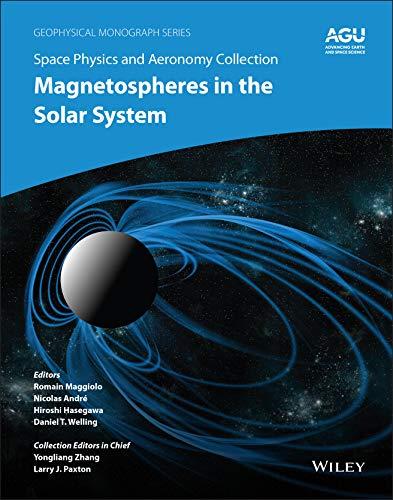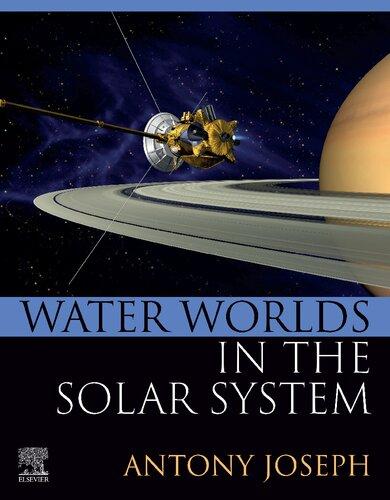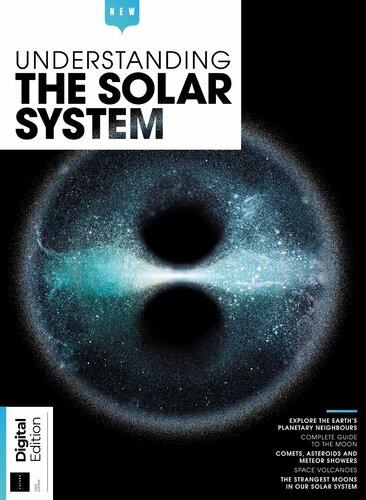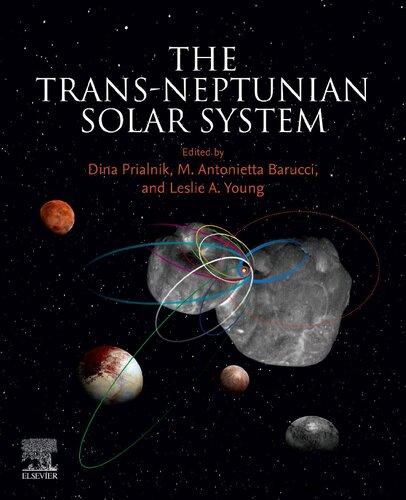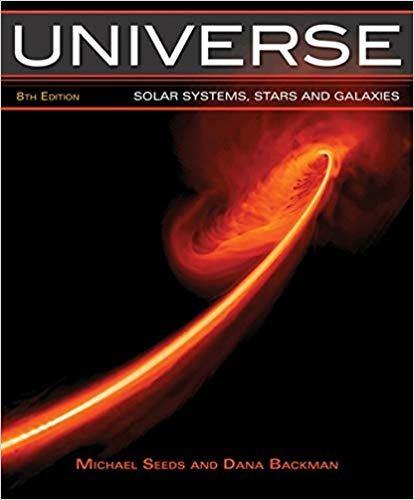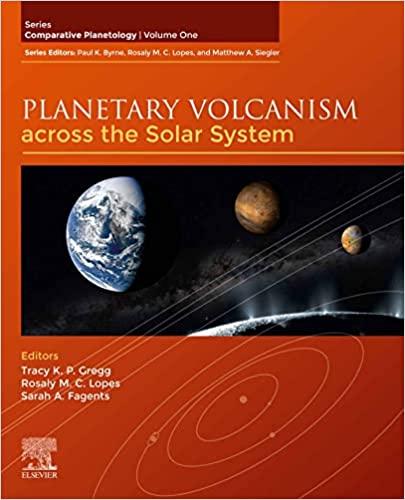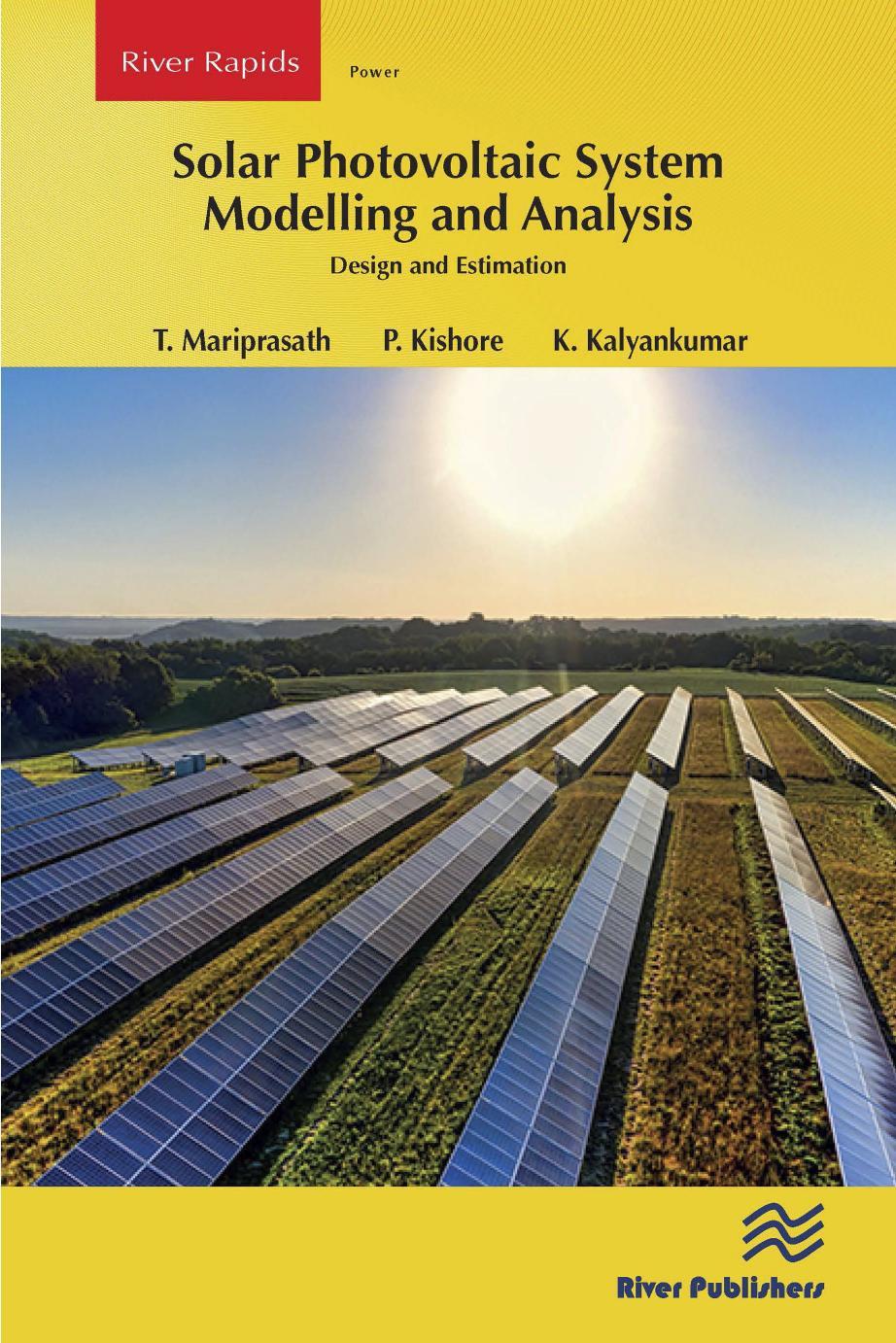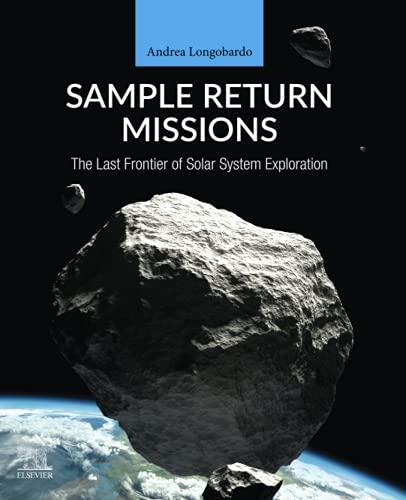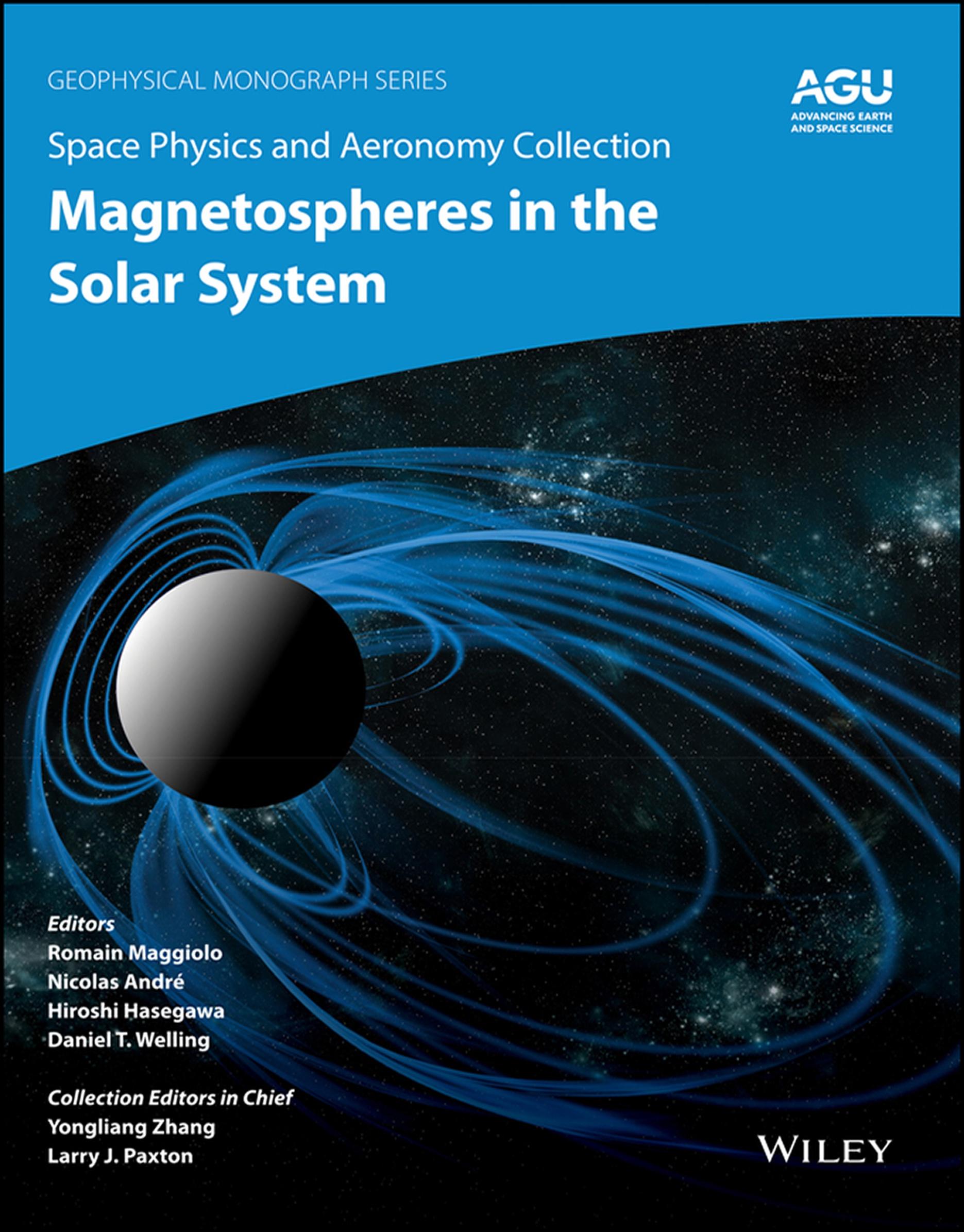Space Physics and Aeronomy, Magnetospheres in the Solar System Romain Maggiolo Visit to download the full and correct content document: https://ebookmass.com/product/space-physics-and-aeronomy-magnetospheres-in-the -solar-system-romain-maggiolo/
More products digital (pdf, epub, mobi) instant download maybe you interests ...
Water Worlds in the Solar System Antony Joseph
https://ebookmass.com/product/water-worlds-in-the-solar-systemantony-joseph/
The Solar System 9th Edition, (Ebook PDF)
https://ebookmass.com/product/the-solar-system-9th-edition-ebookpdf/
Understanding The Solar System 1st Edition Future Publishing Limited
https://ebookmass.com/product/understanding-the-solar-system-1stedition-future-publishing-limited/
The Trans-Neptunian Solar System 1st Edition Dina Prialnik
https://ebookmass.com/product/the-trans-neptunian-solarsystem-1st-edition-dina-prialnik/
(eBook PDF) Universe Solar System, Stars and Galaxies 8th Edition
https://ebookmass.com/product/ebook-pdf-universe-solar-systemstars-and-galaxies-8th-edition/
Planetary Volcanism across the Solar System 1st Edition
Tracy K. P. Gregg
https://ebookmass.com/product/planetary-volcanism-across-thesolar-system-1st-edition-tracy-k-p-gregg/
Solar Photovoltaic System Modelling and Analysis: Design and Estimation (River Publishers Series in Power) 1st Edition Mariprasath
https://ebookmass.com/product/solar-photovoltaic-systemmodelling-and-analysis-design-and-estimation-river-publishersseries-in-power-1st-edition-mariprasath/
Solar Fuels (Advances in Solar Cell Materials and Storage) Nurdan Demirci Sankir
https://ebookmass.com/product/solar-fuels-advances-in-solar-cellmaterials-and-storage-nurdan-demirci-sankir/
Sample Return Missions: The Last Frontier of Solar System Exploration 1st Edition Andrea Longobardo
https://ebookmass.com/product/sample-return-missions-the-lastfrontier-of-solar-system-exploration-1st-edition-andrealongobardo/
GeophysicalMonographSeries 212TheEarlyEarth:AccretionandDifferentiation JamesBadro andMichaelWalter(Eds.)
213GlobalVegetationDynamics:ConceptsandApplicationsin theMC1Model DominiqueBacheletandDavid Turner(Eds.)
214ExtremeEvents:Observations,ModelingandEconomics MarioChavez,MichaelGhil,andJaimeUrrutiaFucugauchi(Eds.)
215AuroralDynamicsandSpaceWeather YongliangZhangand LarryPaxton(Eds.)
216Low-FrequencyWavesinSpacePlasmas AndreasKeiling, Dong-HunLee,andValeryNakariakov(Eds.)
217DeepEarth:PhysicsandChemistryoftheLowerMantleand Core HidenoriTerasakiandRebeccaA.Fischer(Eds.)
218IntegratedImagingoftheEarth:TheoryandApplications MaxMoorkamp,PeterG.Lelievre,NiklasLinde,andAmir Khan(Eds.)
219PlateBoundariesandNaturalHazards JoaoDuarteand WouterSchellart(Eds.)
220IonosphericSpaceWeather:LongitudeandHemispheric DependencesandLowerAtmosphereForcingTimothy Fuller-Rowell, EndawokeYizengaw,PatriciaH.Doherty, andSunandaBasu(Eds.)
221TerrestrialWaterCycleandClimateChangeNaturaland Human-InducedImpacts QiuhongTangandTaikan Oki(Eds.)
222Magnetosphere-IonosphereCouplingintheSolarSystem CharlesR.Chappell,RobertW.Schunk,PeterM.Banks, JamesL.Burch,andRichardM.Thorne(Eds.)
223NaturalHazardUncertaintyAssessment:Modelingand DecisionSupport KarinRiley,PeterWebley,andMatthew Thompson(Eds.)
224HydrodynamicsofTime-PeriodicGroundwaterFlow: DiffusionWavesinPorousMedia JoeS.DepnerandToddC Rasmussen(Auth.)
225ActiveGlobalSeismology IbrahimCemenandYucel Yilmaz(Eds.)
226ClimateExtremes SimonWang(Ed.)
227FaultZoneDynamicProcesses MarionThomas(Ed.)
228FloodDamageSurveyandAssessment:NewInsightsfrom ResearchandPractice DanielaMolinari,SciraMenoni,and FrancescoBallio(Eds.)
229Water-Energy-FoodNexus – PrinciplesandPractices P. AbdulSalam,SangamShrestha,VishnuPrasadPandey,and AnilKAnal(Eds.)
230Dawn–DuskAsymmetriesinPlanetaryPlasmaEnvironments SteinHaaland,AndreiRounov,andColinForsyth(Eds.)
231BioenergyandLandUseChange ZhangcaiQin,Umakant Mishra,andAstleyHastings(Eds.)
232MicrostructuralGeochronology:PlanetaryRecordsDown toAtomScale DesmondMoser,FernandoCorfu,James Darling,StevenReddy,andKimberlyTait(Eds.)
233GlobalFloodHazard:ApplicationsinModeling,Mapping andForecasting GuySchumann,PaulD.Bates,GiuseppeT Aronica,andHeikoApel(Eds.)
234Pre-EarthquakeProcesses:AMultidisciplinaryApproachto EarthquakePredictionStudies DimitarOuzounov,Sergey Pulinets,KatsumiHattori,andPatrickTaylor(Eds.)
235ElectricCurrentsinGeospaceandBeyond AndreasKeiling, OctavMarghitu,andMichaelWheatland(Eds.)
236QuantifyingUncertaintyinSubsurfaceSystems Celine Scheidt,LewisLi,andJefCaers(Eds.)
237PetroleumEngineering MoshoodSanni(Ed.)
238GeologicalCarbonStorage:SubsurfaceSealsandCaprock Integrity StephanieVialle,JonathanAjo-Franklin,andJ. WilliamCarey(Eds.)
239LithosphericDiscontinuities HuaiyuYuanandBarbara Romanowicz(Eds.)
240ChemostratigraphyAcrossMajorChronologicalEras AlcidesN.Sial,ClaudioGaucher,Muthuvairavasamy Ramkumar,andValderezPintoFerreira(Eds.)
241MathematicalGeoenergy:Discovery,Depletion,and Renewal PaulPukite,DennisCoyne,andDaniel Challou(Eds.)
242OreDeposits:Origin,Exploration,andExploitation Sophie DecreeandLaurenceRobb(Eds.)
243KuroshioCurrent:Physical,BiogeochemicalandEcosystem Dynamics TakeyoshiNagai,HiroakiSaito,KojiSuzuki,and MotomitsuTakahashi(Eds.)
244GeomagneticallyInducedCurrentsfromtheSuntothe PowerGrid JenniferL.Gannon,AndreiSwidinsky,and ZhonghuaXu(Eds.)
245Shale:SubsurfaceScienceandEngineering ThomasDewers, JasonHeath,andMarceloSánchez(Eds.)
246SubmarineLandslides:SubaqueousMassTransportDeposits FromOutcropstoSeismicProfiles KeiOgata,AndreaFesta, andGianAndreaPini(Eds.)
247Iceland:Tectonics,Volcanics,andGlacialFeatures TamieJ Jovanelly
248DaysideMagnetosphereInteractions QiugangZong, PhilippeEscoubet,DavidSibeck,GuanLe,andHui Zhang(Eds.)
249CarboninEarth’sInterior CraigE.Manning,Jung-FuLin,and WendyL.Mao(Eds.)
250NitrogenOverload:EnvironmentalDegradation, Ramifications,andEconomicCosts BrianG.Katz
251BiogeochemicalCycles:EcologicalDriversand EnvironmentalImpact KaterinaDontsova,Zsuzsanna Balogh-Brunstad,andGaëlLeRoux(Eds.)
252SeismoelectricExploration:Theory,Experiments,and Applications NielsGrobbe,AndréRevil,ZhenyaZhu,and EvertSlob(Eds.)
253ElNiñoSouthernOscillationinaChangingClimate Michael J.McPhaden,AgusSantoso,andWenjuCai(Eds.)
254DynamicMagmaEvolution FrancescoVetere(Ed.)
255LargeIgneousProvinces:ADriverofGlobalEnvironmental andBioticChanges Richard.E.Ernst,AlexanderJ.Dickson, andAndreyBekker(Eds.)
256CoastalEcosystemsinTransition:AComparativeAnalysisof theNorthernAdriaticandChesapeakeBay ThomasC. Malone,AlenkaMalej,andJadranFaganeli(Eds.)
257Hydrogeology,ChemicalWeathering,andSoilFormation AllenHunt,MarkusEgli,andBorisFaybishenko(Eds.)
258SolarPhysicsandSolarWind NourE.RaouafiandAngelos Vourlidas(Eds.)
259MagnetospheresintheSolarSystem RomainMaggiolo, NicolasAndré,HiroshiHasegawa,andDanielT. Welling(Eds.)
260IonosphereDynamicsandApplications ChaosongHuang andGangLu(Eds.)
261UpperAtmosphereDynamicsandEnergetics WenbinWang andYongliangZhang(Eds.)
SpacePhysicsandAeronomyCollectionVolume2 GeophysicalMonograph259
MagnetospheresintheSolarSystem RomainMaggiolo
NicolasAndré HiroshiHasegawa
DanielT.Welling
Editors
YongliangZhang
LarryJ.Paxton CollectionEditorsinChief
ThisWorkisaco-publicationoftheAmericanGeophysicalUnionandJohnWileyandSons,Inc.
Thiseditionfirstpublished2021
©2021AmericanGeophysicalUnion
Allrightsreserved.Nopartofthispublicationmaybereproduced,storedinaretrievalsystem,ortransmitted,inanyformorby anymeans,electronic,mechanical,photocopying,recordingorotherwise,exceptaspermittedbylaw.Adviceonhowtoobtain permissiontoreusematerialfromthistitleisavailableathttp://www.wiley.com/go/permissions.
TherightofRomainMaggiolo,NicolasAndré,HiroshiHasegawa,andDanielT.Wellingtobeidentifiedastheeditorofthiswork hasbeenassertedinaccordancewithlaw.
PublishedundertheaegisoftheAGUPublicationsCommittee
BrooksHanson,ExecutiveVicePresident,Science
CarolFrost,Chair,PublicationsCommittee
FordetailsabouttheAmericanGeophysicalUnionvisitusatwww.agu.org
RegisteredOffice
JohnWiley&Sons,Inc.,111RiverStreet,Hoboken,NJ07030,USA
EditorialOffice
111RiverStreet,Hoboken,NJ07030,USA
Fordetailsofourglobaleditorialoffices,customerservices,andmoreinformationaboutWileyproductsvisitusatwww.wiley.com.
Wileyalsopublishesitsbooksinavarietyofelectronicformatsandbyprint-on-demand.Somecontentthatappearsinstandardprint versionsofthisbookmaynotbeavailableinotherformats.
LimitofLiability/DisclaimerofWarranty
Whilethepublisherandauthorshaveusedtheirbesteffortsinpreparingthiswork,theymakenorepresentationsorwarrantieswith respecttotheaccuracyorcompletenessofthecontentsofthisworkandspecificallydisclaimallwarranties,includingwithout limitationanyimpliedwarrantiesofmerchantabilityorfitnessforaparticularpurpose.Nowarrantymaybecreatedorextendedby salesrepresentatives,writtensalesmaterialsorpromotionalstatementsforthiswork.Thefactthatanorganization,website,or productisreferredtointhisworkasacitationand/orpotentialsourceoffurtherinformationdoesnotmeanthatthepublisherand authorsendorsetheinformationorservicestheorganization,website,orproductmayprovideorrecommendationsitmaymake. Thisworkissoldwiththeunderstandingthatthepublisherisnotengagedinrenderingprofessionalservices.Theadviceand strategiescontainedhereinmaynotbesuitableforyoursituation.Youshouldconsultwithaspecialistwhereappropriate.Further, readersshouldbeawarethatwebsiteslistedinthisworkmayhavechangedordisappearedbetweenwhenthisworkwaswrittenand whenitisread.Neitherthepublishernorauthorsshallbeliableforanylossofprofitoranyothercommercialdamages,includingbut notlimitedtospecial,incidental,consequential,orotherdamages.
LibraryofCongressCataloging-in-PublicationData
Names:Maggiolo,Romain,editor.|André,Nicolas,1977– editor.| Hasegawa,Hiroshi,1974– editor.|Welling,DanielT.,editor.
Title:Magnetospheresinthesolarsystem/RomainMaggiolo,Nicolas André,HiroshiHasegawa,DanielT.Welling,editors.
Description:Hoboken,NJ:Wiley-AmericanGeophysicalUnion,[2021]| Includesbibliographicalreferencesandindex.
Identifiers:LCCN2020045732|ISBN9781119507529(cloth)|ISBN9781119829980(adobepdf)|ISBN 9781119815648(epub)
Subjects:LCSH:Magnetosphere.|Planets–Magnetospheres.
Classification:LCCQC809.M35M322021|DDC538/.766–dc23
LCrecordavailableathttps://lccn.loc.gov/2020045732
CoverDesign:Wiley
CoverImage:©MarcWard/Shutterstock
Setin10/12ptTimesNewRomanbySPiGlobal,Pondicherry,India
10987654321
CONTENTS ListofContributors ..................................................................................................................................................ix
Preface ...................................................................................................................................................................xvi
PartI:TheEarthMagnetosphere ...............................................................................................................................1
1ABriefHistoryoftheMagnetosphere ..............................................................................................................3 DavidJ.Southwood
2Large-ScaleStructureandDynamicsoftheMagnetosphere .........................................................................15 DavidG.SibeckandKyleR.Murphy
3TheEquationsoftheMagnetosphere .............................................................................................................37 HerbertGunell
PartII:FundamentalProcesses ...............................................................................................................................47
4MagneticReconnectionintheNear-EarthMagnetotail .................................................................................49 TsugunobuNagai
5TurbulenceandComplexityofMagnetosphericPlasmas...............................................................................67 MariusEchim,TomChang,PeterKovacs,AnnaWawrzaszek,EmiliyaYordanova,YasuhitoNarita, ZoltanVörös,RobertoBruno,WieslawMacek,KaleviMursula,andGiuseppeConsolini
6Wave–ParticleInteractionsintheEarth’sMagnetosphere ............................................................................93 RichardM.Thorne,JacobBortnik,WenLi,andQianliMa
7Cross-ScaleEnergyTransportinSpacePlasmas:ApplicationstotheMagnetopauseBoundary .................109 KatariinaNykyri,XuanyeMa,andJayJohnson
PartIII:SolarWind–MagnetosphereCoupling .....................................................................................................123
8SolarWindInteractionwithEarth’sBowShock ..........................................................................................125 Georges.K.Parks,EnsangLee,ZhongweiW.Yang,NaiguoLin,SuiyanY.Fu,andYingLiu
9TheMagnetosheath ......................................................................................................................................137 YasuhitoNarita,FerdinandPlaschke,andZoltánVörös
10DaysideMagnetopauseProcesses ................................................................................................................153 StephenA.Fuselier
11ThePolarCuspsoftheEarth’sMagnetosphere ............................................................................................163 BenoitLavraudandKarlheinzJ.Trattner
12TheEarth’sLow-LatitudeBoundaryLayer ....................................................................................................177 TakumaK.M.Nakamura
viCONTENTS
PartIV:Magnetosphere–IonosphereCoupling .....................................................................................................193
13Field-AlignedCurrentsintheMagnetosphere–Ionosphere ..........................................................................195 HermannLührandGuramKervalishvili
14IonosphericIonAccelerationandTransport ................................................................................................207 AndrewW.Yau,TakumiAbe,MatsAndré,AndrewD.Howarth,andWilliamK.Peterson
15ColdIonosphericIonsintheMagnetosphere ..............................................................................................219 MatsAndré,SergioToledo-Redondo,andAndrewW.Yau
16Magnetosphere–IonosphereCouplingofPrecipitatingElectronsandIonosphericConductance ...............229 GeorgeV.Khazanov,DavidG.Sibeck,andMikeChu
PartV:TheDynamicMagnetosphere ...................................................................................................................243
17MagnetotailProcesses ..................................................................................................................................245 JoachimBirn,AndreiRunov,andYuriKhotyaintsev
18TheActiveMagnetosphere:SubstormsandStorms .....................................................................................277 YukitoshiNishimuraandLarryR.Lyons
19TheNorthwardIMFMagnetosphere ............................................................................................................293 RobertC.Fear
20ABriefReviewoftheRingCurrentandOutstandingProblems ..................................................................311 RalucaIlie,MuhammadFrazBashir,andElenaA.Kronberg
21Source,Loss,andTransportofEnergeticParticlesDeepInsideEarth’sMagnetosphere(L<4) ..................323 XinlinLi,RichardS.Selesnick,HongZhao,DanielN.Baker,J.BernardBlake,andMichaelA.Temerin
22ThePlasmasphere:ItsInteractionsandDynamics .......................................................................................335 FabienDarrouzet,DennisL.Gallagher,andJohanDeKeyser
23ImpactofIonosphericIonsonMagnetosphericDynamics ..........................................................................353 ElinaA.Kronberg,ElenaE.Grigorenko,RalucaIlie,LynnKistler,andDanWelling
PartVI:PlanetaryMagneticFields ........................................................................................................................365
24PlanetaryMagneticFields .............................................................................................................................367 Karl-HeinzGlassmeierandDanielHeyner
PartVII:InducedMagnetospheres ........................................................................................................................391
25InducedMagnetospheres:Mars ....................................................................................................................393 JasperS.Halekas,JanetG.Luhmann,EduardDubinin,andYingjuanMa
26InducedMagnetospheres:Titan ...................................................................................................................407 CésarBertucci
27BirthofaMagnetosphere .............................................................................................................................427 HansNilsson,EtienneBehar,JamesL.Burch,ChristopherM.Carr,AndersI.Eriksson, Karl-HeinzGlassmeier,PierreHenri,MarinaGaland,CharlotteGoetz,HerbertGunell,and TomasKarlsson
28InducedMagnetospheres:AtmosphericEscape ...........................................................................................441 DavidA.Brain
PartVIII:GiantPlanetMagnetospheres ................................................................................................................453
29TheMagnetodiskRegionsofJupiterandSaturn ..........................................................................................455 NicholasAchilleos,PatickGuio,FlavienHardy,ChrisParanicas,andAriannaM.Sorba
30FastRotatingMagnetospheres:JupiterandSaturnPlasmaSources,LossandTransport ............................471 AbigailM.Rymer
31GasGiantMagnetosphere–Ionosphere–ThermosphereCoupling ................................................................485 LiciaC.RayandJaphethN.Yates
32TheRadiationBeltsofJupiterandSaturn ....................................................................................................499 EliasRoussosandPeterKollmann
33AsymmetricalMagnetospheres:UranusandNeptune .................................................................................515 ChristopherS.ArridgeandCarolPaty
PartIX:Mini-magnetospheresandMoon–MagnetosphereInteractions ...............................................................535
34ADungeyCycleintheLifeofMercury’sMagnetosphere ...........................................................................537 JamesA.Slavin,SuzanneM.Imber,andJimM.Raines
35TheMagnetosphereofGanymede ...............................................................................................................557 XianzheJiaandMargaretG.Kivelson
36OverviewofMoon–MagnetosphereInteractions .........................................................................................575 JoachimSaur
PartX:InvestigatingMagnetosphericProcesses ...................................................................................................595
37GlobalSimulations ........................................................................................................................................597 JoachimRaeder,KaiGermaschewski,WilliamD.Cramer,andJohnLyon
38KineticModelingintheMagnetosphere ......................................................................................................607 StefanoMarkidis,VyacheslavOlshevsky,GáborTóth,YuxiChen,IvyBoPeng,GiovanniLapenta,and TamasGombosi
39Data-BasedModelingoftheEarth’sMagneticField ....................................................................................617 NikolaiTsyganenko,VarvaraAndreeva,MarinaKubyshkina,MikhailSitnov,andGrantStephens
40MultispacecraftMeasurementsInTheMagnetosphere ...............................................................................637 MalcolmW.Dunlop,TieYanWang,XiangChengDong,SteinHaarland,QuanQiShi,HuiShanFu, JohanDeKeyser,ChaoShen,ZhaoJinRong,ChristophePhillippeEscoubet, ZuYinPu,andJonathanEastwood
41ExploringSmallScaleswithMMS ................................................................................................................657 JamesL.BurchandKyoung-JooHwang
42GlobalEnergeticNeutralAtom(ENA)ImagingofMagnetospheres ............................................................673 PontusC.Brandt
43LaboratoryExperiments:PuttingSpaceintotheLab ...................................................................................699 MarkKoepke
PartXI:FutureDirections .....................................................................................................................................715
44ChallengesinModelingtheOuterMagnetosphere ......................................................................................717 GáborTóth,YuxiChen,ZhenguangHuang,andBartvanderHolst
45DoesaMagnetosphereProtecttheIonosphere?..........................................................................................729 RomainMaggioloandHerbertGunell
46SomeUnsolvedProblemsofMagnetosphericPhysics .................................................................................743 MichaelH.Denton
47InstigatorsofFutureChangeinMagnetosphericResearch ..........................................................................753 MichaelW.Liemohn,AmyM.Keesee,L.Kepko,andMarkB.Moldwin Index ......................................................................................................................................................................765 viiiCONTENTS
LISTOFCONTRIBUTORS TakumiAbe
InstituteofSpaceandAstronauticalScience JapanAerospaceExplorationAgency Sagamihara,Kanagawa,Japan
NicholasAchilleos
DepartmentofPhysicsandAstronomy/ CentreforPlanetarySciences UniversityCollegeLondon London,UK
MatsAndré SwedishInstituteofSpacePhysics Uppsala,Sweden
VarvaraAndreeva
InstituteandDepartmentofPhysics Saint-PetersburgStateUniversity Saint-Petersburg,Russia
ChristopherS.Arridge DepartmentofPhysics LancasterUniversity Bailrigg,Lancaster,UK
DanielN.Baker
LaboratoryforAtmosphericandSpacePhysics UniversityofColoradoBoulder Boulder,CO,USA
MuhammadFrazBashir
DepartmentofElectricalandComputerEngineering UniversityofIllinoisatUrbana-Champaign Urbana,IL,USA
EtienneBehar
SwedishInstituteofSpacePhysics Kiruna,Sweden; and
DepartmentofComputerScience,ElectricalandSpace Engineering
LuleåUniversityofTechnology Kiruna,Sweden
CésarBertucci
InstitutodeAstronomíayFísicadelEspacio UniversidaddeBuenosAires/CONICET BuenosAires,Argentina
JoachimBirn SpaceScienceInstitute Boulder,CO,USA; and
LosAlamosNationalLaboratory LosAlamos,NM,USA
J.BernardBlake SpaceSciencesDepartment TheAerospaceCorporation LosAngeles,CA,USA
JacobBortnik DepartmentofAtmosphericandOceanicSciences UniversityofCalifornia LosAngeles,CA,USA
DavidA.Brain LaboratoryforAtmosphericandSpacePhysics UniversityofColoradoBoulder Boulder,CO,USA
PontusC.Brandt JohnsHopkinsUniversityAppliedPhysicsLaboratory Laurel,MD,USA
RobertoBruno TheNationalInstituteforAstrophysics(INAF) Rome,Italy
JamesL.Burch SouthwestResearchInstitute SanAntonio,TX,USA
ChristopherM.Carr DepartmentofPhysics ImperialCollegeLondon London,UK
TomChang MassachusettsInstituteofTechnology Cambridge,USA
YuxiChen CenterforSpaceEnvironmentModeling UniversityofMichigan AnnArbor,MI,USA
xLISTOFCONTRIBUTORS
MikeChu
NOAA,CooperativeInstituteforResearchinthe Atmosphere ColoradoStateUniversity FortCollins,CO,USA
GiuseppeConsolini
TheNationalInstituteforAstrophysics(INAF) Rome,Italy
WilliamD.Cramer SpaceScienceCenter UniversityofNewHampshire Durham,NH,USA
FabienDarrouzet
RoyalBelgianInstituteforSpaceAeronomy Brussels,Belgium
JohanDeKeyser
RoyalBelgianInstituteforSpaceAeronomy Brussels,Belgium
Michael.H.Denton CenterforSpacePlasmaPhysics SpaceScienceInstitute Boulder,CO,USA; and
NewMexicoConsortium LosAlamos,NM,USA
XiangChengDong SchoolofSpaceandEnvironment BeihangUniversity Beijing,China
EduardDubinin
Max-Planck-InstituteforSolarSystemResearch Katlenburg-Lindau,Germany
MalcolmW.Dunlop SchoolofSpaceandEnvironment BeihangUniversity Beijing,China; and
RutherfordAppletonLaboratory Didcot,Oxfordshire,UK
JonathanEastwood
RutherfordAppletonLaboratory Didcot,Oxfordshire,UK
MariusEchim RoyalBelgianInstituteforSpaceAeronomy Brussels,Belgium; and
InstituteofSpaceScience Magurele,Romania
AndersI.Eriksson SwedishInstituteofSpacePhysics ÅngströmLaboratory Uppsala,Sweden
ChristophePhillippeEscoubet EuropeanSpaceAgency/ EuropeanSpaceResearchandTechnologyCentre Noordwijk,TheNetherlands
RobertC.Fear SchoolofPhysicsandAstronomy UniversityofSouthampton Southampton,UK
HuiShanFu SchoolofSpaceandEnvironment BeihangUniversity Beijing,China
SuiyanY.Fu GeophysicsDepartment PekingUniversity Beijing,China
StephenA.Fuselier SouthwestResearchInstitute SanAntonio,TX,USA; and UniversityofTexasatSanAntonio SanAntonio,TX,USA
MarinaGaland DepartmentofPhysics ImperialCollegeLondon London,UK
DennisL.Gallagher NASAMarshallSpaceFlightCenter Huntsville,AL,USA
KaiGermaschewski SpaceScienceCenter UniversityofNewHampshire Durham,NH,USA
Karl-HeinzGlassmeier InstitutfürGeophysikundextraterrestrischePhysik TechnischeUniversitätBraunschweig Braunschweig,Germany
CharlotteGoetz InstitutfürGeophysikundextraterrestrischePhysik TechnischeUniversitätBraunschweig Braunschweig,Germany
TamasGombosi
CenterforSpaceEnvironmentModeling UniversityofMichigan AnnArbor,MI,USA
ElenaE.Grigorenko
SpaceResearchInstituteof RussianAcademyofSciences Moscow,Russia; and
DepartmentofPhysicsoftheEarth Saint-PetersburgStateUniversity Saint-Petersburg,Russia
PatrickGuio
DepartmentofPhysicsandAstronomy/ CentreforPlanetarySciences UniversityCollegeLondon London,UK; and
DepartmentofPhysicsandTechnology ArcticUniversityofNorway Tromsø,Norway
HerbertGunell RoyalBelgianInstituteforSpaceAeronomy Brussels,Belgium; and DepartmentofPhysics UmeåUniversity Umeå,Sweden
SteinHaarland
BirkelandCentreforSpaceScience UniversityofBergen Bergen,Norway
JasperS.Halekas
DepartmentofPhysicsandAstronomy UniversityofIowa IowaCity,IA,USA
FlavienHardy
DepartmentofPhysicsandAstronomy/ CentreforPlanetarySciences UniversityCollegeLondon London,UK
PierreHenri
LaboratoiredePhysiqueetChimiedel’Environnementet del’Espace
UMR7328CNRS – Universitéd’Orléans Orléans,France
DanielHeyner InstitutfürGeophysikundextraterrestrischePhysik TechnischeUniversitätBraunschweig Braunschweig,Germany
AndrewD.Howarth DepartmentofPhysicsandAstronomy UniversityofCalgary Calgary,AB,Canada
ZhenguangHuang CenterforSpaceEnvironmentModeling UniversityofMichigan AnnArbor,MI,USA
Kyoung-JooHwang SouthwestResearchInstitute SanAntonio,TX,USA
RalucaIlie DepartmentofElectricalandComputerEngineering UniversityofIllinoisatUrbana-Champaign Urbana,IL,USA
SuzanneM.Imber DepartmentofClimateandSpaceSciencesand Engineering UniversityofMichigan AnnArbor,MI,USA; and DepartmentofPhysicsandAstronomy UniversityofLeicester Leicester,UK
XianzheJia DepartmentofClimateandSpaceSciencesand Engineering UniversityofMichigan AnnArbor,MI,USA
JayJohnson DepartmentofEngineering AndrewsUniversity BerrienSprings,MI,USA
TomasKarlsson DepartmentofSpaceandPlasmaPhysics SchoolofElectricalEngineeringand ComputerScience KTHRoyalInstituteofTechnology Stockholm,Sweden
AmyM.Keesee DepartmentofPhysicsandSpaceScienceCenter UniversityofNewHampshire Durham,NH,USA
xiiLISTOFCONTRIBUTORS
LarryKepko
SpaceWeatherLaboratory HeliophysicsScienceDivision NASAGoddardSpaceFlightCenter Greenbelt,MD,USA
GuramKervalishvili
GFZ – GermanResearchCentreforGeosciences Section2.3,Geomagnetism Potsdam,Germany
GeorgeV.Khazanov NASAGoddardSpaceFlightCenter Greenbelt,MD,USA
YuriKhotyaintsev
SwedishInstituteofSpacePhysics Uppsala,Sweden
LynnKistler SpaceScienceCenter UniversityofNewHampshire Durham,NH,USA
MargaretG.Kivelson DepartmentofClimateandSpaceSciencesand Engineering UniversityofMichigan AnnArbor,MI,USA; and
DepartmentofEarth,Planetary,andSpaceSciences UniversityofCalifornia LosAngeles,CA,USA
MarkKoepke DepartmentofPhysicsandAstronomy WestVirginiaUniversity Morgantown,WV,USA; and DepartmentofPhysics UniversityofStrathclyde Glasgow,UK
PeterKollmann
JohnsHopkinsUniversityAppliedPhysicsLaboratory Laurel,MD,USA
PeterKovacs MiningandGeologicalSurveyofHungary Budapest,Hungary
ElenaA.Kronberg MaxPlanckInstituteforSolarSystemResearch Göttingen,Germany; and
DepartmentofEarthandEnvironmentalSciences (Geophysics) LudwigMaximilianUniversityofMunich Munich,Germany
MarinaKubyshkina InstituteandDepartmentofPhysics Saint-PetersburgStateUniversity Saint-Petersburg,Russia
GiovanniLapenta DepartmentofMathematics KatholiekeUniversiteitLeuven Leuven,Belgium
BenoitLavraud InstitutdeRechercheenAstrophysiqueetPlanétologie CNRS,UPS,CNES UniversitédeToulouse Toulouse,France; and
Laboratoired'astrophysiquedeBordeaux CNRS UniversitédeBordeaux Pessac,France
EnsangLee SchoolofSpaceResearch KyungHeeUniversity Yongin,SouthKorea
WenLi CenterforSpacePhysics BostonUniversity Boston,MA,USA
XinlinLi LaboratoryforAtmosphericandSpacePhysics UniversityofColoradoBoulder Boulder,CO,USA; and
DepartmentofAerospaceEngineeringSciences UniversityofColoradoBoulder Boulder,CO,USA
MichaelW.Liemohn DepartmentofClimateandSpaceSciencesand Engineering UniversityofMichigan AnnArbor,MI,USA
NaiguoLin SpaceSciencesLaboratory UniversityofCalifornia,Berkeley Berkeley,CA,USA
YingLiu
KeyLaboratoryforSpaceWeather ChineseAcademyofSciences Beijing,China
JanetG.Luhmann
SpaceSciencesLaboratory UniversityofCalifornia Berkeley,CA,USA
HermannLühr
GFZ – GermanResearchCentreforGeosciences Section2.3,Geomagnetism Potsdam,Germany
JohnLyon DepartmentofPhysicsandAstronomy DartmouthCollege Hanover,NH,USA
LarryR.Lyons
DepartmentofAtmosphericandOceanicSciences UniversityofCalifornia LosAngeles,CA,USA
QianliMa DepartmentofAtmosphericandOceanicSciences UniversityofCalifornia LosAngeles,CA,USA; and CenterforSpacePhysics BostonUniversity Boston,MA,USA
XuanyeMa CenterforSpaceandAtmosphericResearchandPhysical SciencesDepartment Embry-RiddleAeronauticalUniversity DaytonaBeach,FL,USA
YingjuanMa Earth,PlanetaryandSpaceSciences UniversityofCalifornia LosAngeles,CA,USA
RomainMaggiolo RoyalBelgianInstituteforSpaceAeronomy Brussels,Belgium
WieslawMacek SpaceResearchCentre PolishAcademyofSciences Warsaw,Poland
StefanoMarkidis KTHRoyalInstituteofTechnology Stockholm,Sweden
MarkB.Moldwin DepartmentofClimateandSpaceSciencesand Engineering UniversityofMichigan AnnArbor,MI,USA
KyleR.Murphy NASAGoddardSpaceFlightCentre Greenbelt,MD,USA; and DepartmentofAstronomy UniversityofMaryland CollegePark,MD,USA
KaleviMursula DepartmentofPhysics UniversityofOulu Oulu,Finland
TakumaK.M.Nakamura SpaceResearchInstitute AustrianAcademyofSciences Graz,Austria; and InstituteofPhysics UniversityofGraz Graz,Austria
YasuhitoNarita SpaceResearchInstitute AustrianAcademyofSciences Graz,Austria
TsugunobuNagai InstituteofSpaceandAstronauticalScience JapanAerospaceExplorationAgency Sagamihara,Japan
HansNilsson SwedishInstituteofSpacePhysics Kiruna,Sweden
YukitoshiNishimura DepartmentofElectricalandComputerEngineeringand CenterforSpacePhysics BostonUniversity Boston,MA,USA
KatariinaNykyri CenterforSpaceandAtmosphericResearchandPhysical SciencesDepartment Embry-RiddleAeronauticalUniversity DaytonaBeach,FL,USA
xivLISTOFCONTRIBUTORS
VyacheslavOlshevsky KTHRoyalInstituteofTechnology Stockholm,Sweden
ChrisParanicas
JohnsHopkinsUniversityAppliedPhysicsLaboratory Laurel,MD,USA
Georges.K.Parks SpaceSciencesLaboratory UniversityofCalifornia,Berkeley Berkeley,CA,USA
CarolPaty DepartmentofEarthSciences UniversityofOregon Eugene,OR,USA
IvyBoPeng LawrenceLivermoreNationalLaboratory Livermore,CA,USA
WilliamK.Peterson LaboratoryofAtmosphericandSpacePhysics UniversityofColoradoBoulder Boulder,CO,USA
FerdinandPlaschke SpaceResearchInstitute AustrianAcademyofSciences Graz,Austria
ZuYinPu SchoolofEarthandSpaceSciences PekingUniversity Beijing,China
JoachimRaeder SpaceScienceCenter UniversityofNewHampshire Durham,NH,USA
JimM.Raines DepartmentofClimateandSpaceSciencesand Engineering UniversityofMichigan AnnArbor,MI,USA
LiciaC.Ray DepartmentofPhysics LancasterUniversity Lancaster,UK
ZhaoJinRong InstituteofGeologyandGeophysics ChineseAcademyofSciences Beijing,China
EliasRoussos MaxPlanckInstituteforSolarSystemResearch Goettingen,Germany
AndreiRunov DepartmentofEarth,Planetary,andSpaceSciences UniversityofCalifornia LosAngeles,CA,USA
AbigailM.Rymer JohnsHopkinsUniversityAppliedPhysicsLaboratory Laurel,MD,USA
JoachimSaur InstitutfürGeophysikundMeteorologie UniversityofCologne Cologne,Germany
RichardS.Selesnick SpaceVehiclesDirectorate AirForceResearchLaboratory KirtlandAFB,NM,USA
ChaoShen HarbinInstituteofTechnology Shenzhen,China
QuanQiShi InstituteofSpaceSciences ShandongUniversity Weihai,China
DavidG.Sibeck NASAGoddardSpaceFlightCenter Greenbelt,MD,USA
MikhailSitnov JohnsHopkinsUniversityAppliedPhysicsLaboratory Laurel,MD,USA
JamesA.Slavin DepartmentofClimateandSpaceSciencesand Engineering UniversityofMichigan AnnArbor,MI,USA
AriannaM.Sorba DepartmentofPhysicsandAstronomy/ CentreforPlanetarySciences UniversityCollegeLondon London,UK
DavidJ.Southwood SpaceandAtmosphericPhysics ImperialCollege London,UK
GrantStephens JohnsHopkinsUniversityAppliedPhysicsLaboratory Laurel,MD,USA
MichaelA.Temerin SpaceSciencesLaboratory UniversityofCalifornia Berkeley,CA,USA
RichardM.Thorne DepartmentofAtmosphericandOceanicSciences UniversityofCalifornia LosAngeles,CA,USA
SergioToledo-Redondo InstitutdeRechercheenAstrophysiqueetPlanétologie CNRS,UPS,CNES UniversitédeToulouse Toulouse,France
GáborTóth CenterforSpaceEnvironmentModeling UniversityofMichigan AnnArbor,MI,USA
KarlheinzJ.Trattner LaboratoryforAtmosphericandSpacePhysics UniversityofColoradoBoulder Boulder,CO,USA
NikolaiTsyganenko InstituteandDepartmentofPhysics Saint-PetersburgStateUniversity Saint-Petersburg,Russia
BartvanderHolst CenterforSpaceEnvironmentModeling UniversityofMichigan AnnArbor,MI,USA
ZoltánVörös SpaceResearchInstitute AustrianAcademyofSciences Graz,Austria
TieYanWang RutherfordAppletonLaboratory Didcot,Oxfordshire,UK
AnnaWawrzaszek SpaceResearchCentre PolishAcademyofSciences Warsaw,Poland
DanWelling DepartmentofPhysics UniversityofTexasatArlington Arlington,TX,USA
ZhongweiW.Yang KeyLaboratoryforSpaceWeather ChineseAcademyofSciences Beijing,China
JaphethN.Yates EuropeanSpaceAstronomyCentre EuropeanSpaceAgency Madrid,Spain
AndrewW.Yau DepartmentofPhysicsandAstronomy UniversityofCalgary Calgary,AB,Canada
EmiliyaYordanova SwedishInstituteofSpacePhysics Uppsala,Sweden
HongZhao LaboratoryforAtmosphericandSpacePhysics UniversityofColoradoBoulder Boulder,CO,USA
PREFACE Introducedin1958,thetermmagnetosphererefersto themagneticcavitysurroundingacelestialbody.Invisible tothehumaneyes,magnetospherescanonlybeexplored throughthedevelopmentofinstruments,theoriesand numericalmodels.Withtheadventofthespaceagewe havestartedexploringtheminsituandaccumulatedan impressiveamountofdataovertheyears.Sixtyyearsafter thetermmagnetospherewasbeendefined,itischallengingtoreviewtheexistingknowledgeonsolarsystemmagnetospheresinonesinglebook.
Thisbookprovidesanoverviewofthemagnetospheresin thesolarsystem,fromthesmallinducedmagnetospheres thatformaroundunmagnetizedbodiestothelargemagnetospheresofthegiantplanets.Magnetospheresarehighly complex,structuredandtime-dependentsystemsconstantlyinteractingwiththesolarwindandthecomponents oftheplanetarysystems,suchastheirionosphere,atmosphere,surface,rings,andmoons.Eachmagnetosphereis uniqueandcontainsvariousintertwiningsubregions,particlepopulations,andplasmaprocesses.Thisexplainsthe scientificinterestofmagnetosphericphysics:magnetospheresareaccessiblenaturallaboratoriesforstudyingfundamentalphysicalprocessesofuniversalapplication. Moreover,theEarth’smagnetosphereisakeycomponent ofournear-spaceenvironmentonwhichourmodernsocietiesareincreasinglydependent.
Thebookisdividedinelevensectionsthatcoverthe currentstateofourunderstandingaswellasfuturedirectionsforscientists.PartIstartswithabriefhistoryofmagnetospheresandpresentsthebasicprinciplesand equations.PartIIaddressesthefundamentalprocesses thatgovernmagnetosphericphysics.Thethreefollowing sectionsarededicatedtotheEarth’smagnetosphere,the moststudiedandbestknownofthesolarsystemmagnetospheres.Theyrespectivelyfocusonitscouplingwiththe Earth’sionosphere(partIII),itscouplingwiththesolar wind(partIV),anditsdynamics(partV).Thenextsections areorientedtowardothersolarsystembodies.Aftera discussionaboutplanetarymagneticfieldsinpartVI,we focusontheinducedmagnetospheresinpartVII,onthe
magnetospheresofgiantplanetsinpartVIIIand,in partIX,on “minimagnetospheres”,suchasthoseof Mercuryandmagnetizedmoons.PartXconsidersthetools thatareusedtoinvestigatemagnetosphericprocesses. Finally,partXIdiscussesthekeyquestionsandchallenges tobeaddressedinthecomingyears,providingsome insightsonthefuturedevelopmentsofmagnetospheric research.Thechapterscontainedhereinincludecontributionsfromexperimentalists,theoreticians,andnumerical modelers.
Wehopethatthisbookwillbearesourceforboththe noviceresearcherandtheexperiencedscientist.Forthose lessacquaintedwithcurrenttopicsinEarthandplanetary magnetosphericresearch,thisbookwillprovidethebackgroundmaterialrequiredtobeknowledgeableonthe currentstateoftheart.Forexperts,itwillactasareferencetothemostimportantmagnetosphericsciencebreakthroughsandhelpexpandthereader’shorizonswithits coverageofthediversenear-bodyregionsinspace.With thisbook,wehopethatthereaderwillcomprehendmost ofthefeaturesofmagnetospheresandfindthekeysto delveasfaraspossibleintothem.
Wegratefullyacknowledgesupportandguidancefrom RituparnaBoseandDanielFinchofJohnWiley&Sons, Inc.throughthebookproposalprocess,theexternalpeer reviewofthechapters,andthebookproductionprocess. Wealsothankalltheauthorsfortheircontributionandall thereviewersfortheirassistance.
ThisbookisdedicatedtothememoryofRichardM. Thorne.
RomainMaggiolo RoyalBelgianInstituteforSpaceAeronomy, Belgium
NicolasAndré ResearchInstituteinAstrophysics andPlanetology,France
HiroshiHasegawa JapanAerospaceExplorationAgency,Japan
DanielT.Welling UniversityofTexasatArlington,USA
TheEarthMagnetosphere 1 ABriefHistoryoftheMagnetosphere DavidJ.Southwood
ABSTRACT TheearlyhistoryofthemagnetosphereistakenfromtheearliestsuggestionsofamaterialtransportbetweenSun andEarthbySabineinthenineteenthcentury,throughtheworkofbothBirkelandandChapmanandcoworkers intheearlytwentiethcenturytothenamingofthemagnetosphere,theproposaloftheopenmagnetosphere,and thediscoveriesofthefirstdecadeandahalfofthespaceage.
1.1.INTRODUCTION Onecouldbeginahistoryofthemagnetosphereasearly as1600whenGilbertpublishedhis “DeMagnete,” which firsttreatedthemagnetismoftheEarthashavingan embeddedplanetarydipole.Alternatively,onecouldstart withthecoiningofthetermbyThomasGoldintheearly spaceagein1959.AsneitherGilbertnorGoldreallyunderstoodwhatturnedouttobethemostsensitiveandbasicscientificissues,itisprobablyagoodcompromisetostart withEdwardSabinein1852(Sabine,1852).Inhisreport totheRoyalSocietyofLondon,Sabinewasthefirstto glimpsedimlythenatureoftheelectromagneticcoupling betweentheSunandEarththatisfundamentaltoboth theformationofthemagnetosphereandalsoitsactivity.
1.2.BRITISHWORKINTHENINETEENTH CENTURY EdwardSabinewasabothscientistandasoldier,in thelattercapacityseeingserviceinNorthAmericain theWarof1812.Hisinterestingeophysicsstemmedinitiallyfromworkingingeodesy.Hemovedfrommeasuringterrestrialgravitytothestudyoftheterrestrial magneticfield,whichherealizedneededtobesurveyed
SpaceandAtmosphericPhysics,ImperialCollege, London,UK
globally.Nodoubtafterpointingouttohissuperiorsina maritimenationwithaglobalempiretherelevanceof understandingthemagneticfieldfornavigationalpurposes,ColonelSabinesetupmagneticobservatories acrosstheglobe.His1852paperreportsresultsonthe variationofthefieldwithtimeatthewidelyseparated locationsofTorontoandHobarton(nowHobart,Tasmania).Diurnalvariationsareseenbutalsothereare disturbancesdetectedatbothsiteswidelyseparatedin longitudeandlatitude.Themostimportantcomment hemakesforourpurposeistorelatehisresultstothose ofaGermanastronomer,HeinrichSchwabe,whohad proposedfromalongrecordofsolarobservationsthat sunspotsexhibitedaregular11yearcycle.Sabinenoted thatthevariationinglobalmagneticactivityappearedto matchSchwabe’ssunspotperiod.Hefurthernotedthat Schwabehadfailedtodetectanychangeinterrestrialclimateonthesamescale.Hethengoesontomaketheprescientremark “Butitisquiteconceivablethataffections ofthegaseousenvelopeoftheSun,orcausesoccasioning thoseaffections,maygiverisetosensiblemagnetical effectsatthesurfaceofourplanet,withoutproducingsensiblethermiceffects ” Theword “sensible” hereisinthe (archaic)senseof “detectable ” . Thefirstobservationsofwhatwenowknowtobea directcorrelationbetweenasolarphenomenonandageomagneticresponsecamewithinafewyears.In1859a globalmagneticdisturbanceoccurred,nowcalledthe
SpacePhysicsandAeronomyCollectionVolume2:MagnetospheresintheSolarSystem,GeophysicalMonograph259,FirstEdition. EditedbyRomainMaggiolo,NicolasAndré,HiroshiHasegawa,andDanielT.Welling. ©2021AmericanGeophysicalUnion.Published2021byJohnWiley&Sons,Inc. DOI:10.1002/9781119815624.ch1
Carringtonstorm(Carrington,1860).Thereisanironyin thisattribution.WhatCarringtonactuallyreportedtothe RoyalAstronomicalSocietywasthefirstobservationof whitelightflaresontheSun.Inhisreporthedoesrefer toanalmostsimultaneousmagneticdisturbancefollowed about17hourslaterbylargemagneticdisturbances.The observationswouldhavebeenprovidedbyBalfourStewartandcamefromKew(nearLondon)(Stewart,1860).In thediscussionofthemagneticobservations,Carrington wasaskedwhethertherewasadirectrelationshipbetween themagneticdisturbancesandtheextremesolarevent;he repliedcautiously “…. Whilethecontemporaryoccurrence maydeservenoting,hewouldnothaveitsupposedthathe evenleanstowardshastilyconnectingthem.Oneswallow doesnotmakeasummer. ” (Carrington,1860).Balfour Stewart(1860)reportedonthemagneticeventsandhad nosuchcaution.Extendedmagneticdisturbanceswere recordedgloballybetween28Augustand2September 1859.Hepointedoutthatauroraldisplayswereseenin partsoftheBritishEmpire(e.g.intheCaribbean,in India)wheretheyhadneverbeenseenbeforeorsince. Inhisreportonthosedisturbances,hedescribedCarrington’sobservationsbutaftergentlycriticizingCarrington ’ s caution,heinvokedspecificallySabine ’searlierresult. “SinceGeneralSabinehasprovedthatarelationsubsists betweenmagneticdisturbancesandsunspots,itisnot impossibletosupposethatinthiscaseourluminarywas takenintheact ” RemovingtheBritishunderstatement, thisstatementdirectlysupportsthenotionofaSun–Earth connection.
Thequasi-instantaneoussignalwouldhavebeendueto modificationoftheionosphericconductivitybyincident X-rayandUVradiation,thusenhancingthemagneticsignalsassociatedwiththedailydynamomotionintheionosphere.Thedelayedsignalwouldhavebeentheshockof flarematerialarrivinganddisruptingthemagnetosphere. Itwouldbeyearsbeforetheseexplanationsbecamecommoncurrency.
Carrington ’scautionreflectedthetenorofthetimes.In thatera,KelvinandRayleighruledtheBritishscientific roostandneitherscientistwasinclinedtoacceptthat materialcouldmovedirectlythroughspacefromSunto Earth.DespitehisreferringdirectlytoSabine’s(1852) resultandtheeventsof1859,Kelvin’sassessmentwas madeclearinhispresidentialaddresstotheRoyalSociety in1892(Kelvin,1892).
Southwood(2015)creditsStewartwithkeepingalive theideathattheremightbeamaterialconnectionbetween theSunandEarthfollowingCarrington’sreport.Aswe seelater,itwascarriedforwardbyhisstudentArthur Schuster.Schusteralsodidmuchtoelucidatesolarand lunarpatterns.Usingfourmagneticstations,Schuster andLamb(1889)providedthebasicbreakdownofthe regularmagneticdiurnalpatternsofdisturbancefixed withrespecttotheSunandalsoalunarcomponent
originallyidentifiedbySabine(1861).However,bythe endofthenineteenthcenturythereremainedanopen questionoverthelargestglobaldisturbances,whichshow noobviouslinkwithtimeofdaybutdidvaryinintensity overthesolarcycle.Thecodificationofthelunar(L)and Solar(Sq)quietdaycurrentpatternswasundertakenby SydneyChapman(1913)usingmuchmorecoverage(21 stations)(Matsushita,1968).Theglobalmagneticpattern forthemagneticallydisturbedperiodsorgeomagnetic stormswasalsodistinctive.Thepatternwascalledthedisturbancesystem(SD or DS).Followingalargeamountof magneticsurveyworkfortheBritishRoyalObservatory, Chapman(1919)publishedapaperoutliningthemagnetic disturbancepatternsandcontainingwhatisthefirst attemptbyaBritonforatheory.However,beforewelook atwhathesaidandwhereitled,oneshouldnotethatthere hadbeenmuchearliersuggestionsconcerningthesource ofgeomagneticdisturbancesandtheauroraetheybringin theirwake.
1.3.SCANDINAVIANWORKINTHE NINEETEENTHCENTURY TheBritishanalysisofmagn eticdisturbanceswasstatistical.Itwasassumedthatthesignalsoriginatedin motionofaconductingpartoftheatmosphere.The synchingofsignalswithlunarorsolarphasemakesa statisticalapproachnatural.Unsurprisingly,Chapman wantedtolookatthedistu rbedmagneticsignalsina similarway.ThiswasnottheapproachoftheScandinavianswholivedundertheauroraandsawitnight bynight.
KristianBirkelandisoneofNorway’sgreatestscientists.Hewasbornin1867inKristiania,latertobecome Oslo.Fromacomfortablebackground,hisexceptional natureshowedearlyon.AfteruniversityinKristiania, in1893,helefttogotoParistostudyattheEcolePolytechniquewherehisinitialinterestwasinthenewscience ofelectromagnetismcomingfromMaxwell’sunifying equations.AftertravelelsewhereinEuropehereturned toNorwaytobecometheyoungestprofessorintheuniversityinKristiania.
EvenforaNorwegianfromasfarsouthaspresent-day Oslo,theauroraisanaturalinterest.Untilthenineteenth centurytheaurorawasoftenassumedtobeanatmosphericeffect.Despitetheconcurrentauroraldisturbances inthegreatmagneticstormof1859referredtoabove,the questionofauroraloriginandanyelectromagneticeffect orlinktotheSunappearsnottohavebeenexamined muchfurtherintheUK.ItwasBirkelandwhopicked upthescientificchallengeofexplainingtheaurora.
Birkeland’slifeandworkareablydiscussedinEgeland andBurke’smonograph(EgelandandBurke,2005). WhenhereturnedtoNorway,Birkelandwasthoroughly
groundedinelectromagnetismandexperimentaltechnique.Moreover,hewaswellawareofthenewdiscovery oftheelectronbyJ.J.Thompsonin1897.Hesuspected thatthisnewphysicsmaycontainanexplanationofauroralorigin.Neveramantoshyfromexperimentalworkor observation,heorganizedaseriesofexpeditionstonorthernNorwayandarrangedsubsidiaryobservationselsewhereinRussiaandIceland.Althoughthefirst expeditionwasabandonedthroughextremeweather, theworkestablishedovertimeavastbodyofobservations documentedinaseriesofvolumes(Birkeland,1901,1908, 1913).Theheightoftheaurorawasshowntobearound 100km.Theelectromagneticnatureoftheauroraitself wasfirmlyestablishedbyshowingthathorizontalcurrents,theauroralelectrojet,flowintheactualdisplays. Birkelandspeculatedthatthesourceoftheaurorallight isduetoelectronsofextraterrestrialoriginimpacting theupperatmosphere.HehadconstructedamodelEarth inavacuumchamber(aterrella)andonexposingittoa beamofelectronssucceededincreatingaringoflight aroundthemagneticpoles,mimickingtheshapeofthe actualauroralzone.Hesentapaperto Nature advancing hisideathattheaurorarepresentsincidentbeamsofelectronsofsolarorigin.Atthispoint,fateintervenedasthe paperwassenttoArthurSchustertoreferee.Schuster recommendedrejectionashepointedoutthatthebeam ofnegativelychargedparticleswouldbequenchedby anelectricfieldastheSunwouldchargepositiveand theEarthchargenegative.Birkelandrecognizedthat theargumentwascorrectandimmediatelymodifiedthe ideatoproposeanelectricallyneutralstreamofcharged particlesfromtheSun,i.e.whatisnowcalledplasma.Possiblystungbytherejection,Birkelandneverresubmitted themodifiedideato Nature butincludeditintheformal reportsoftheexpeditions.Thereportpublishedin1908 (Birkeland,1908)includedasketchlikethatreproduced inFigure1.1(fromSouthwood,2015).Diagramssuch asthis,showingdownwardcurrententeringtheupper atmosphereatonelongitude,flowingthroughithorizontallyandleavingbyanupwardreturncurrentataseparatelongitude,arenowcommonplace.Birkelandhad madethefirstsketchofthethree-dimensionalelectrical currentsystemofanauroraldisturbance.Thesketch wouldberecognizedtoday.
1.4.SCHISM Nature isaBritishjournaland,intheearlyyearsofthe twentiethcentury,Britainwaspossiblythemostimportantscientificnation.ItseemslikelythathadBirkeland’ s correctedideabeenpublishedintheBritishliterature,it mighthaveforestalledwhatbecameamajorschismin thesciencecommunity.PartoftheproblemwasphilosophicalbutSouthwoodandBrekke(2017)suggestthat
Figure1.1 ReproductionfromSouthwood(2015)ofthesketch onp.105ofVolume1ofBirkeland’sreportonthe1902–1903 polarexpeditions(Birkeland,1908).Itisnotquiteclearin Birkeland’stext,butthedottedanddashedlinesrepresentthe streamingchargesofoppositesigninachargeneutralstream fromtheSun.
partwaspersonalembarrassmentforamanwhowasfast becomingthedominantBritishnameinthefield.As alreadynoted,Chapman(1919)hadmadeamajoranalysisofmagneticdataassociatedwithwhathadbeenidentifiedasthedisturbedtimecurrentsystem.However,the paperincludedanappendixthatputforwardthesame ideathatBirkelandhadoriginallypropoundedmorethan adecadebefore.Chapmanproposedthatthedisturbances wereduetoelectronsincidentontheatmosphere.The errorwascaughtrapidlyafterpublicationbyLindemann (1919),whopublishedacritiqueeffectivelysuggesting,as Birkelandhaddonealready,thattheremightbeaneutral streamofpositiveandnegativelychargedparticlesfrom theSun.Southwood(2015)pointedoutthat,although ChapmanwasmostlikelyunawareofBirkeland’sidea, Schuster(1911)appearedtohavegraspedtheidea.However,after1919,Britishreferences[andevenAmerican references(e.g.Parker,1969)]attributetheneutralstream notiontoLindemann.
TheantipathybetweentheBritishandScandinavian schoolscontinuedforaround40yearsuntilsophisticated resultsfromspacebroughtittoanend.Thediscussionby Fukushima(1994)isinformative.Chapmanfeltstatistical informationwasfundamental.Healsohadamathematicalreasonforignoringthepossibilityofcurrentsflowing intoandoutoftheupperionizedatmosphere,theionosphere.Itwasauniquenesstheorem.ThemagneticperturbationsrecordedonthesurfaceoftheEarthcouldalways beattributedtoauniquesetofcurrentsintheconducting
ionosphereifitwasassumednocurrentflowedinandout ofthetopoftheionosphere.Foranygivenfieldpattern thesewerereferredtoastheequivalentcurrentsystem. Therehad,nonetheless,beenworkbyVestineandChapman(1938)thatpurportedtoshowthatthepurelyhorizontalcurrentmodelofChapmanfitteddatabetter. Fukushima(1969)showedthatthemodelproposedby VestineandChapmantorepresentthatofBirkeland wassomewhatunreasonable.Changingtheassumption tosomethingmorerationalrevealedthattherewaslittle tochoosebetweenthesystems.Fukushima(1971)further showedexplicitlythatthecurrentsystemabovetheionosphereisshieldedfromtheground,i.e.undetectable.
1.5.CHAPMAN–FERRARO:ACAVITYIN ASTREAMOFCHARGEDPARTICLESFROM THESUN In1927,V.C.A.Ferrarobeganpostgraduatestudywith ChapmanatImperialCollegeLondon.Chapman’searlier workhadshownthatageomagneticstormbeganwithan increaseofthemagneticfieldworldwide.Thedelay betweenevidenceofanythingoccurringontheSunand thearrivalemphasizedthatthesolar–terrestrialconnection wasnotthroughelectromagneticradiationbutwastransmittedviamaterial(corpuscular)means.Chapmangave Ferrarothemagneticstormproblemtostudy(Ferraro, 1969).HewastoexaminetheeffectofaneutralunmagnetizedstreamofchargedparticlesfromtheSunimpingingon theterrestrialmagneticfield(ChapmanandFerraro,1930, 1931,1932,1933).Thetheoryprecededanynotionofmagnetohydrodynamicsandfrozen-inmagneticfield;space betweentheEarthandtheSunwastreatedasunmagnetized.Thestreamwasshowntoenclosethegeomagnetic fieldinacavity.Thiswasthefirstidentificationofaterrestrialmagneticdomainthatwouldeventuallybenamedthe magnetosphere.Thegeomagneticfieldcavitywasbounded byacurrentsheetnowcalledthemagnetopause.Theconfinementoftheterrestrialfieldwithinabubblewithinthe streamwellexplainedtheexistenceofaterrestrialmagnetic cavity,whoseinternalfieldwouldincreaseifincreasedoutflowoccurredfromtheSun.Themathematicalsolution usedtoillustratethemagneticconfinementusedatwodimensionalimagedipole,asshowninFigure1.2.30years later,JimDungeypublishedananalytictwo-dimensional solutionoftheChapman–Ferraroproblemin1961 (Dungey1961a).Bythen,computershadadvancedenough thatthree-dimensionalnumericalsolutionswereaboutto appear(SpreiterandBriggs,1962).
Unfortunately,asitstood,theChapman–Ferraro modeldidnotexplainmuchmoreaboutmagneticstorms thantheincreaseinglobalfieldatstormonset.Onefeature ofthemodelisthepointsmarkedQinFigure1.2,wherethe
Figure1.2 TheChapman–Ferrarocavity.Reproductionof ChapmanandFerraro’ssketchofthenoon–midnightmeridian oftheenclosureoftheEarth’sfieldbyaneutralstreamof solarchargedparticles.Thefieldpatternshownisproduced byanimagedipoleonthelefthandside.ThelettersQmark magneticneutralpointsontheboundary.
fieldgoestozero.Itwasrecognizedthatparticlesmight enterthecavityhereandguidedbythefieldwouldimpinge ontheatmosphereataurorallatitudes.Nevertheless, althoughthelatitudewasright,therewasnomechanism toexplainhowtheaurorawasseenonthenightside.
Asecondmajorproblemwasthataftertheinitial increaseinterrestrialfieldinthemainphaseofageomagneticstorm,thefieldwasdepressedgenerallybyamuch largeramountthantheinitialenhancement.Daglis etal.(1999)notethatthedepressionofthefieldinthe mainphasehadbeenknownsincethenineteenthcentury. (Fitzgerald,1892),Chapman(1919),and,twoyearsearlier,Schmidt(1917)hadsuggestedthatthedepression wasduetosolarchargedparticlesencirclingtheEarth. ChapmanandFerraro’stheorydidproposethatsolar particlessomehowprogressivelypenetratedtotheterrestrialmagneticcavitysothatthecurrentbuiltupbut understandingwouldreallyonlyarriveonceasignificant externalfieldwasallowedfor.
1.6.ALFVÉN:THEORYOFSTORMSANDTHE ADVENTOFMAGNETOHYDRODYNAMICS Inthe1940s,HannesAlfvénandhisresearchgroup basedinStockholmbecamethemajorproponentsof theScandinavianschool.
Alfvén(1939,1940)proposedanewstormmodel focusedonexplainingtheaccessofchargedparticlesto maketheringcurrentandtheaurora.Itwaswrong,partly duetoacompleterejectionofChapman’sideas.The
stream of charged solar particles
theoryassumedthatamagnetizedincidentchargedparticlestreamwasabletosimplyflowontotheEarthfield.In otherwords,therewasnoallowanceforamagnetopause.
AlfvénhimselfwasagreatadmirerofBirkelandandthe modeldoesresembleadevelopmentofhisideas.Themodel alsointroducedtheimportantideaoftherebeinganelectric fieldwithintheterrestrialenvironmentduetothesolar interaction,effectivelyplacingavoltageimposedfromoutsideontheterrestrialsystem.Theinducedelectricfield meantthattherewasapotentialforthesolarmaterialto doworkontheterrestrialsystem.Inpractice,theabsence ofinclusionoftheeffectsthatcausethemagnetopauseto formmeantthatAlfvén’selectricfieldwasinthewrong direction.Nevertheless,itsintroductionwasimportant.
In1942,Alfvénmadeanenormousstepinashort Nature paper(Alfvén,1942),whichintroducedtheidea ofthemagneticfieldbeingfrozenintoaperfectlyconductingmediumlikeaplasma.Thisisseenastheinventionof magnetohydrodynamics(MHD).ItexplainedthemagnetizednatureofanyplasmaflowingfromtheSun(asAlfvén’sstormmodelrequired)butitalsogaveanintuitive waytoseetheformationofacurrentsheetormagnetopausebetweensolarandterrestrialplasma(whichAlfvén’sstormmodelhadignored).
1.7.THESPACEAGEBEGINS TheChapman–Ferraromodelmadeitappeartoohard forsolarplasmatoentertheterrestrialmagneticenvironmentandAlfvén’sappearedtomakeittooeasy.Itwas anothertwentyyearsbeforetheseedsofwhatisnow thegenerallyacceptedmodelweresown.Bythattime thespaceagehadbegunandmuchnewinformation wasemerging.
Atthebeginningofthe1950s,Biermann(1951)had deducedthepresenceofthesolarwindfromthebehavior ofcomettails.Parker(1958)furtherexplainedthatnot onlywasitsflowsupersonicbutalsoitwouldbemagnetized.In1958also,themagnetospherereceiveditsname fromGold(1959).Gold’spaperwasmotivatedbythefirst majordiscoveryofthespaceage,theVanAllenradiation belts(VanAllenandFrank,1959).Despitethefactthat retrospectivelyitwasseenthatSputnik2hadmeasured them(Dessler,1984),thefirstreportswerefromthefirst USEarthorbitingspacecraft,Explorer1.Outinspaceit wasfoundthatthedistantmagneticdipolefieldofthe Earthwasadequatetotrapalargeamountofenergetic chargedparticles.Gold(1959)introducedaveryimportantconcept,theinterchangemotionoffluxtubes.Unfortunately,becauseheattributedthechargedparticlestoa sourcenearEarth[thecosmicrayalbedoneutrondecay theory,CRANDseee.g.Singer(1958),Vernovetal., (1959)],hispaperwasinerror.HeproposedthatthecreationofradiationbeltparticlesnearEarthwouldinducea
naturaloverturningmotioninmagnetosphericmagnetic fluxtubeswhereindensertubesmoveoutwardsandemptiertubesmovein.TheCRANDsourcecanremainrelevanttothehighestenergyparticles(seee.g.Lietal., 2017).However,mostoftheradiationbeltparticlesand thelowerenergyparticlesthatareresponsibleforcarrying theringcurrentoriginatefromthesolarenvironment. Kellogg(1959)firstsuggestedasolarsourcefortheVan Allenparticles.Theexternalsourcemeansthattheparticlesareinjectedandenergymustbesuppliedfortheinjectionprocess.Thisisadriveninterchangemotion(cf. SouthwoodandKivelson,1989).Theenergyisinpractice providedfromthesolarwindthroughpartoftheBirkelandcurrentsystemdiscussedlater.
Alsoin1959,DesslerandParker(1959)madeamajor breakthroughinunderstandingthemainphaseofgeomagneticstorms.Theyproposedthatsolarplasmaentry tothemagnetospherewasenhancedfollowingtheinitial compressionofthemagnetosphereatthestartofastorm becausetheboundaryofthemagnetospherewouldbe unstable.Theythenderivedarelationbetweenthedepressioninthefieldandtheenergyofthechargedparticles trappedinthemagnetosphericfieldfortwospecialphase spacedistributionsofparticles,whichwasgeneralizedby Sckopke(1966).Theideaofenhancedsolarparticleentry duringmainphaseproducingaringcurrentaroundthe Earthwasrightbuttheentryprocessremainedtobe identified.
Weshallreturntodiscussparticleinjectionandtransportafterintroducingtheopenmagnetosphere modelnext.
1.8.DUNGEY:THEOPENMAGNETOSPHERE Dungeyfreelyadmittedthathisopenmagnetospheric model(Dungey1961b)wasinspiredbythesimilarity betweentheionospheric DS disturbedtimecurrentpatternandthemotioninastirredcupofcoffee(Stern, 1986).Ashestirredmilkintothecoffeebymovinghis spoonacrossthecenterofthecuphenotedthecirculation patternresembledthatinFigure1.3.
DungeyhadstudiedforaPhDtenyearsearlierworking onanideaofHoyle’sthatauroraemightoriginatefrom accelerationatmagneticneutrallinesthatwouldform betweenaterrestrialdipolefieldandauniformexterior field(Stern,1986).Cruciallyherealizedin1960thatthe magneticconfigurationwouldallowthesolarwindto drivethefamiliarDScurrentsystemintheionosphere.
By1960,MHDwasthewaypeoplethought;thefrozenfieldideaisbuiltintoDungey’smodel.However,MHDis anapproximationandwillbreakdownwhereverthefield isverysmallorvariesrapidlyonthescaleofchargedparticleLarmorradii.Reconnectioncorrespondstooneform ofbreakdown.Dungey’ s doctoralwork(Dungey,1950)
Figure1.3 TheionosphericDSflowpattern.Theantisunward motionathighlatitudesandthereturnatremindedDungey ofthepatternfromstirringcoffee.
hadintroducedtheideaofmagneticreconnection.Near neutralpointsinthemagneticfield,thefrozen-infieldis nolongervalidandfieldlinescanbe “broken.” Thefinal elementofthenewmodelwasmagneticreconnection.
Figure1.3reproducesanidealizedformoftheionosphericflowshowingthe DS pattern.Thesketchisapolar viewofthenorthernhemispherewiththedashedlines representingtheionosphericplasmastreamlinesdeduced fromthemagneticperturbationsmeasuredattheEarth’ s surface.Thereisatwinvortexflow.Thedottedboundary markswheretheflowswitchesfromsunwardontheequatorwardsidetoantisunwardpoleward.Dungeysuggested thatsunwardmomentumwastransferredalongthemagneticfieldtodrivetheantisunwardflowinthepolar region.Therewouldbeareturnsunwardflowatlowlatitudes.Theflowrepresentsequipotentialsoftheionosphericelectricfield.Itisimportanttonotethatthe electricfieldinducedinthelowlatitudesubauroral regionsisoppositetothatproposedbyAlfvén(1940) andtheflowisoppositetowhatwouldhavebeentheoverallpatternproducedbytheGold(1959)mechanism.
Figure1.4showsthecirculationoffluxtubesinthe noon–midnightmeridianintheopenmodel.Thefigure isshownwithasouthwardinterplanetaryfieldcomponent,thesimplestcaseasitissymmetric.Themagnetic fieldthreadsthemagnetopauseshownbythedashedline. Throughouttheflowismarkedbywhitearrowsinthe
Figure1.4 Dungey’sopenmagnetosphere.Thesimplestcaseofapurelysouthwardinterplanetaryfield(IMF)is assumed.Thesketchisdrawninthenoon–midnightmeridian.Thedashedcurverepresentsthemagnetopause. Thedarkarrowsrepresentthesolarwindflow,openarrowstheflowinducedintheterrestrialenvironment. DaysideandnightsidemagneticreconnectionoccursatthelocationsindicatedbyX.Thenumbersrepresent theenvisagedfieldlinemotionsequenceinsteadystate:solarwind(1),daysidereconnection(2),polarcap connection(3),tailreconnection(4),nightsideinwardmotion(5),daysideoutwardmotiontoreconnection oncemore(6).Thesketchisschematicasthetailonthenightsideextends>100RE (RE =Earthradius) (Dungey,1965).
Figure1.5 Dawn–duskmeridianviewofopenmagnetospherewithpuresouthwardexternalfield.Thesolarwind flowisintothepage.Thesolarwindelectricfieldvoltage ΔΦ isprojecteddownthe(equipotential)fieldlinesofthe polarcaptothepolarionosphere.
interiorofthemagnetosphere.Fieldlinesandplasma moveasawholeasthefieldisfrozenintothemotion. TheexceptionisinthetwoplacesmarkedbyXwhere reconnectionoccurs.Herethefieldlinesbreakandreconnect.Numbersonthefigureoutlinehowasinglefieldline evolvesinasteadyconfigurationwithreconnectionoccurringonthedayside(2),nightside(4)todaysidereconnectiononcemore(6).Plasmainflowtowardsthecenterof thetailfromeachtaillobeisbalancedbyacceleratedoutflowstowardstheEarthanddowntail.Theantisolarflow isonthefieldinthepolarcap.Theblackarrowsrepresent thesolarwindflow.Thedirectconnectionofthesolar windmagneticfieldtothepolarcapmagneticfieldiswhat causesthepolarcapantisolarflow.Atlowerlatitudesthe sunwardflowreturnsmagneticfluxtothedaysidereconnectionpoint.
Thedawn–duskelevationoftheDungeymodelis showninFigure1.5inthesimplestpurelysouthward externalfieldcase.Inthissketch,theelectricfieldconfigurationisillustrated.Inthesteadystatetheflowing plasmaandthesouthwardfieldinthesolarwindgiverise toaneastwardelectricfieldandapotentialdropalongthe neutrallinewherereconnectiontakesplace.Thatpotentialisprojectedintothepolarcapalongthefieldlines asindicatedinthesketch.
AfurthersketchisshowninFigure1.6,whichillustratestheresultingcurrentsystemintheionospheredue totheelectricpotentialimposedacrosstheionosphere
atthefeetofthefluxtubesintheionosphere.ThecontinuousarrowedthinlinesinFigure1.6representtheionosphereHallcurrent.Itisassumed,onceagainfor simplicity,thattheionospherehasauniformconductance.TheHallcurrentisinpreciselytheoppositesense tothedoublevortexflowsystemthatDungeyenvisaged wouldbeinducedbymomentumtransferfromthesolar windintheionosphere.TheHallcurrentisnondissipative.However,thereisalsoadissipativecurrent,thePedersencurrentinthedirectionoftheimposedelectricfield. ThePedersencurrentflowisindicatedbydashedarrowed lines.ItcanbeseenfromthearrowsthatthePedersencurrentchangessenseasonecrossesthelocationrepresented bythethickovalcurve.Onmagnetohydrodynamictime scales,electricalcurrentsaredivergence-free.Accordingly,thenetinfloworoutflowofhorizontalcurrentthat occursintheovalregionmeansthattherehastobecurrentflowalong(upordown)themagneticfieldhere. ThesearethecurrentspostulatedbyBirkeland(1908) andarecommonlycalledBirkelandcurrents.Localized magneticperturbationsweredirectlyobservedabove theauroralzonein1966(Zmudaetal.,1967)andlinked toBirkeland’soriginalproposalbyCummingsandDessler(1967).
ComparisonofFigures1.5and1.6showsthattheBirkelandcurrentsconnectthevoltageassociatedwiththe solarwindmotiontoanionosphericloadrepresented bythedissipativePedersenconductance.
Currents Pederen Hall Birkeland
Figure1.6 Sketchofthecurrentsinducedintheionosphereinthesimple(southwardIMF)openmagnetosphere. ThePedersencurrentsarediscontinuousattheovalcurve,whichcorrespondstotheauroralzone.Thefieldaligned Birkelandcurrentflowin/outatthediscontinuity.Thefieldlinespolewardoftheovalareopenandextendinto interplanetaryspace.Equatorwardthefieldlinesgofromnortherntosouthernhemisphereandsoareclosed. ComparingtheconfigurationsofFigures1.5and1.6showsthattheionosphereactsasaloadonthesolarwind.
MHDtreatstheelectricfieldparalleltothebackground fieldasnegligible,sotheBirkelandcurrentsmightseemto benondissipative.Thisisnotnecessarilyso.Theelectrons everywherewouldneedbeinfinitelymobile.Current (i.e.electrons)isdrawnalongthefieldsimplytoensure thatoverallcurrentsclose.Aslongasthereisareservoir ofcoldelectronssuchasintheionosphere,thiscanbe achievedwithverysmallvoltages.However,wherethe large-scalecurrentflowrequiresupwardcurrentand accordinglydownwardmotionofelectronsfroma magnetosphericsource,substantialvoltagesmaybe needed.Thebasiccalculationwassurprisinglylatein coming(Knight,1973).Theaccelerationofelectrons downintotheionosphereprovidesauroraandalsocan exciteradiowaves(auroralkilometricradiation) (Gurnett,1974).
1.9.PARTICLETRANSPORTINTHE OPENMODEL In1963camethefirstdetectionoftheboundary ofthemagnetosphere,themagnetopause(Cahilland
Amazeen,1963).Dungey ’ ssketchinthe1961paper didnotshowasharpboundarybetweensolarandterrestrialregimesandtherewerethosewhosawthesharp boundarypredictedbyChapmanandFerraroasevidenceagainstanopenmodel,regardlessofthefactthat itwasclearthatsomeformofparticleentryhadtooccur. Ofcourse,theinterplanetaryfieldisrarelypurelysouthward.Thesimplesymmetryoftheinternalmagnetosphericcirculationintheopenmodeloutlinedin Figures1.3–1.6hereismodifiedandskewedbyaddition ofeastward,westwardorradialexternalfields(seee.g. Cowley1981a,1981b).OneshouldalsonotethatthediagraminFigure1.4isschematic.Itmaybetopologically correctbut,intruth,themagneticfieldisverydistended onthenightside,aregionknownasthegeomagnetictail withathinneutralsheetinthecenter.Nightsidereconnectiontakesplaceinthesheetandplasma,whichhas enteredbymovingalongthefieldinthepolarcap, maybeacceleratedthere.
ThefirstevidencethatDungey’smodelmagnetosphere wassoundcameinthemid-1960sfromexperimentalevidence(FairfieldandCahill,1966)thatgeomagneticactivityincreasedwithasouthwardinterplanetarymagnetic
V Dusk Sun Dawn
Ionospheric surface
fieldcomponent.However,thereconnectionmodelwas slowingainingwideacceptance.
Theopenmagnetosphereprovidedastraightforward explanationfornotonlyentryofplasmafromthesolar environmentbutalsoforaccelerationandheating.Ina steady-statepictureofacirculationofplasmawehave alreadydescribed,theplasmacontainedontheclosedflux tubesmovingtowardstheEarthfromthetailencounters fluxtubesofdecreasingvolume.Asaresult,itisheated adiabaticallyi.e.becauseitisisolatedthermally,itsaccessiblephasespacevolumeisconstant;decreasingphysical volumemeansincreasedthermalmotion.Theinward motionisthedriveninterchangemotionreferredtoearlier andtheadiabaticprocesswasdescribedbyGold(1959). Gold’senvisagedmotionwasoutwardandspontaneous. Thefactthattheinwardmovingplasmaisheatedisthe reasonthatthemotionmustbedrivenwithenergyultimatelycomingfromthesolarwind.Becausethemotion oftheplasmaiscollision-free,theenergygainasparticles aremovedtowardstheEarthispitchangledependent. Twoadiabaticinvariants,themagneticmomentandlongitudinalinvariantdescribethemotiontransversetothe fieldandalongthefieldrespectively.Thelongitudinal invariantgovernsplasmamotionalongthefield.The invariantappearsmisnamedinamagnetosphericcontext, asthecorrespondingparticlemotionisthebouncemotion betweenmagneticmirrorsbackandforthinlatitudealong themagneticfield.Itwasoriginallyderivedinthecontrollednuclearfusionprogram,wherethecorresponding motionwasalongthedevice.Detailedanalysisoftheadiabaticmotionwiththetwoinvariantsmentionedaswell asathird,thefluxinvariantassociatedwithdriftaround theEarth,wasworkedoutinthe1950s.AnexcellenttheoreticaloverviewisgivenbyNorthropandTeller(1960). Nakadaetal.(1965)organizedspacecraftenergeticparticledatatoderivethephasespacedistributionusingthe firsttwoinvariantsandshowedexplicitlythatthesource wasexternal.
Eachinvarianthasanassociatedperiodicmotion.In practice,solarwindmagnetospherecouplingisnot steady.Themagnetosphericcirculationproceedsinfits andstarts,mostlyontimescalesshortcomparedwith thetimechargedparticlestaketomovearoundtheEarth. Thismeansthattheinjectionofparticlesfromthetailin theclosedfieldregiontakesplaceinasporadicmanner. Asaresult,withintheclosedfieldregionthemotionof manyoftheenergeticparticlesthatmakeuptheringcurrentandtheradiationbeltsisbestdescribedasadiffusion. Particleradialmotionisarandomwalkasparticlesmove inoroutaccordingtowheretheyareintheirdriftphaseas solarterrestrialcouplingvaries.Anearlycomprehensive studyisgiveninSchulzandLanzerotti(1974).
Ifthefieldvariesonatimeorspacescalecomparable withtheLarmorgyrationthemomentinvariantis
violatedand,similarly,variationonthebouncetimescale willchangethelongitudinalinvariant.Itfollowsthat plasmawavesatfrequenciesneartheelectronoriongyrofrequencycanmodifythemagneticmomentandproduce scatteringinpitchangle.Withasmallenoughpitchangle, energeticchargedparticlesarelostastheirmirrorpoints becomeoflowenoughaltitudethattheycollidewith atmosphericneutrals.Anearlyanalysisofthecoupling betweenpitchanglescatteringandbackgroundwave instabilitywasdonebyKennelandPetschek(1966), whousedtheapproachtoderivealimitonstablytrapped particlefluxthatfittedwellwithenergeticparticledata fromtheearlyExplorer12and14spacecraft.
Inpractice,thesolarterrestrialinteractionoccurson severaltimescales.Asolarwindpressureincreasewill produceanincreaseintheEarth’sfieldworldwide,known asastormsuddencommencementinminutes.Subsequently,changesinthedirectionoftheinterplanetary fieldwillproduceaseriesofburstsofmagnetospherewide flowdrivenbythesolarwindfromthepolarcap,as describedintheprevioussection.Thesearealsothefits andstartsreferredtoabove.AkasofuandChapman (1961)introducedthetermsubstormtodescribethis. Theypointedoutthatthephenomenonwhosetimescale istypicallyaroundtwohourshadoriginallybeenidentifiedbyBirkeland(1908)asapolarelementarystorm. Plasmainjectionandheatingoccurwitheachsubstorm, eventuallybuildinguparingcurrentaroundEarthover adayortwo.Theringcurrentcarriedbytheinjectedparticlesprovidesthegeomagneticfielddepressionwhich characterizesthestormmainphase.
1.10.CONCLUDINGREMARKS Byaround1970orso,notonlyhadthebasicgeography ofthemagnetospherebeenestablishedbutalsoalotofthe groundworkhadbeendoneforunderstandinghowit worked.However,anhonesthistoryneedstonotethat therewasstillalargedegreeofcontroversy.Indeed,much ofthiswasechoingtheScandinavian–Anglo-Saxon schismofthe1940sand1950s.Itwasnotgenerallyseen thatDungey’sopenmagnetospheremodelbroughtcriticalaspectsofbothmodelstogether.Forinstance,afinal importantmorphologicaldiscoveryin1971wasofmagnetosheathplasmapenetratingdeepintheterrestrialfield, thepolarcusp(HeikkilaandWinningham,1971;Frank, 1971).Despitetheknownpresenceofanexternalfield, manyimmediatelyidentifiedtheresultwiththelikely entryofplasmathroughtheChapman–Ferraroneutral points(markedQinFigure1.2).Moreover,anearly paperbyRusselletal.(1971)evencontainedthetantalizinginformationthatthecuspappearedtomoveupor downinlatitudeastheexternalfieldturnednorthward orsouthward.Nevertheless,thepapermadenoreference
totheDungeymodel.Similarly,inthepreviousyeara paperbyAubryetal.(1970)hadshownthemagnetopause erodingatlowlatitudesinthepresenceofasouthward externalfieldbutalsomentionedneitherDungeynor reconnection.Reconnectionhadbecomeacontroversial terminmagnetosphericphysicsatthistime (Southwood,2015).ThefinaldenouementoftheDungey openreconnectionmodelofthemagnetospherehadto awaitthedirecthighresolutionobservationsofheating andplasmaaccelerationinthemagnetopauseinconditionspreciselyconsistentwithreconnectionbytheISEE (InternationalSunEarthExplorer)1and2spacecraft (Paschmannetal.,1979).
ACKNOWLEDGMENTS WorkatImperialCollegewassupportedbyUKSTFC GrantsST/K001051/1andST/N000692/1.
REFERENCES Akasofu,S.-I.,andS.C.Chapman(1961),Theringcurrent,geomagneticdisturbanceandtheVanAllenradiationbelts, J. Geophys.Res.,66,1321–1350.
Alfvén,H.(1939),Atheoryofmagneticstormsandoftheaurorae, K.Sven.Vetenskapakad.Handl.,Ser. 3,18(3),9. (ReprintedinpartwithcommentsbyAlexDesslerandJohn Wilcoxin Eos,51,180–194,1970.)
Alfvén,H.(1940),Atheoryofmagneticstormsandoftheaurorae,II,Theaurorae;III,Themagneticdisturbances. K.Sven. Vetenskapakad.Handl.,Ser.3,18(9).
Alfvén,H.(1942),Existenceofelectromagnetic-hydrodynamic waves, Nature,150,405,doi:10.1038/150405d0.
Aubry,M.P.,C.T.Russell,andM.G.Kivelson(1970),Inward motionofthemagnetopausebeforeasubstorm, J.Geophys. Res.,75,7018–7031,doi:10.1029/JA075i034p07018.
BiermannL(1951),KometenschweifeundKorpuskularstrahlung, Z.Astrophys.,29,274–286.
Birkeland,K.(1901),ExpeditionNorvegiennede1899–1900 pourl’etudedesauroresboréales,Videnskapsselskapetsskrifter.1,MatematiskNaturvidenskapeligKlasse,1901,No.1, EnCommissionchezJacobDybwad,A.W.Brogger,Christiana,Norway.
Birkeland.K.,(1908),TheNorwegianAuroraPolarisExpedition,1902–1903,vol.I,section1.H.Aschehoug,Oslo. Birkeland,K.(1913),TheNorwegianAuroraPolarisExpedition,1902–1903,vol.I,section2.H.Aschehoug.Oslo. Cahill,L.J.,Jr.,andP.G.Amazeen(1963),Theboundaryofthe geomagneticfield, J.Geophys.Res.,68(7),1835–1843,doi. org/10.1029/JZ068i007p01835.
Carrington,R.C.(1860),Descriptionofasingularappearance seenintheSunonSeptemberI,1959, Mon.Not.R.Astron. Soc.,20,13–15.
Chapman,S.C.(1913),Onthediurnalvariationsoftheearth’ s magnetismproducedbythemoonandsun, Phil.Trans.R. Soc.Lond.A,213,279–321.
Chapman,S.C.(1919),Anoutlineofatheoryofmagnetic storms, Proc.R.Soc.Lond.A,95,61–83.
Chapman,S.andV.C.A.Ferraro(1930),Anewtheoryofmagneticstorms, Nature,126,129–130.
Chapman,S.andV.C.A.Ferraro(1931),Anewtheoryofmagneticstorms,I,Theinitialphase, Terr.Magn.Atmos.Elect. (nowJ.Geophys.Res.),36,77–97,171–186.
Chapman,S.andV.C.A.Ferraro,(1932)Anewtheory ofmagneticstorms,I,Theinitialphase(continued), Terr. Magn.Atmos.Elect.(nowJ.Geophys.Res.),37,147–156, 421–429.
Chapman, S. andV.C.A.Ferraro(1933),Anewtheoryofmagneticstorms,II,Themainphase, Terr.Magn.Atmos.Elect. (nowJ.Geophys.Res.),38,79–96.
Cowley,S.W.H.,(1981a),Magnetosphericasymmetries associatedwiththeY-componentoftheIMF, Planet.Space Sci.,29,79.
Cowley,S.W.H.(1981b),Asymmetryeffectsassociatedwith theX-componentoftheIMFinamagneticallyopenmagnetosphere, Planet.SpaceSci.,29,809.
Cummings,W.D.,andA.J.Dessler(1967),Field-alignedcurrentsinthemagnetosphere, J.Geophys.Res.,72(3),1007–1013,doi:10.1029/JZ072i003p01007.
Daglis,I.A.,R.M.Thorne,W.Baumjohann,andS.Orsini (1999),Theterrestrialringcurrent:Origin,formation,and decay, Rev.Geophys.,37(4),407–438,doi:10.1029/ 1999RG900009.
Dessler,A.J.(1984),TheVernovRadiationBelt(Almost), Science,226,915.
Dessler,A.J.,andE.N.Parker,(1959),Hydromagnetictheory ofgeomagneticstorms, J.Geophys.Res.,64,2239–2252.
Dungey,J.W.(1950),Someresearchesincosmicmagnetism. PhDthesis,CambridgeUniversity.
Dungey,J.W.(1961a),ThesteadystateoftheChapman Ferraroproblemintwodimensions, J.Geophys.Res., 35,1043.
Dungey,J.W.(1961b),Interplanetarymagneticfieldandthe auroralzones, Phys.Rev.Lett.,6,47–48.
Dungey,J.W.(1965),Thelengthofthemagnetospheric tail, J.Geophys.Res.,70(7),1753–1753,doi:10.1029/ JZ070i007p01753.
EgelandA.,andW.J.Burke(2005),KristianBirkeland,The FirstSpaceScientist.AstrophysicsandSpaceScienceLibrary, Springer,Dordrecht.
Fairfield,D.H.,andL.J.CahillJr.(1966),Transitionregion magneticfieldandpolarmagneticdisturbances, J.Geophys. Res.,71,(1),155–169,doi10.1029/JZ071i001p00155.
Ferraro,V.C.A.(1969),Thebirthofatheory.InS.-I.Akasofu, B.Fogle,andB.Haurwitz(Eds.), SidneyChapman,Eighty (pp.14–18).UniversityofColoradoPress,Boulder. Fitzgerald,G.F.(1892),Sunspotsandmagneticstorms, The Electrician,30,48.
Frank,L.A.(1971),Plasmaintheearth’spolarmagnetosphere, J.Geophys.Res.,76,5202–5219.
Fukushima,N.(1969)Equivalenceingroundgeomagnetic effectofChapman-Vestine’sandBirkeland-Alfvénelectric current-systemsforpolarmagneticstorms, Rep.Ionos.Space Res.Jap.,23,219–227.
Fukushima,N.(1971),Electriccurrentsystemsforpolarsubstormsandtheirmagneticeffectbelowandabovetheionosphere, RadioScience,6,269–275,doi.org/10.1029/ RS006i002p00269.
Fukushima,N.(1994),Sometopicsandhistoricalepisodesin geomagnetismandaeronomy, J.Geophys.Res.,99(A10), 19113–19142.
Gold,T.(1959),MotionsinthemagnetosphereoftheEarth, J. Geophys.Res.,64,1219–1224.
Gurnett,D.A.(1974),TheEarthasaradiosource:Terrestrial kilometricradiation, J.Geophys.Res.,79,4227–4238. Heikkila,W.J.andJ.D.Winningham(1971),Penetrationof magnetosheathplasmatolowaltitudesthroughthedayside magnetosphericcusps, J.Geophys.Res.,76,883–891. Kellogg,P.J.,(1959),VanAllenradiationofsolarorigin, Nature,183,1295–1297.
Kelvin,LordW.T.(1892),RoyalSocietyPresidentialAddress, Nature,47,107–110.
Kennel,C.F.,andPetschek,H.E.(1966),Limitonstably trappedparticlefluxes, J.Geophys.Res.,71(1),1–28. Knight,S.(1973),Parallelelectricfields, Planet.SpaceSci.,21, 741–750.
Li,X.,R.Selesnick,Q.Schiller,K.Zhang,H.Zhao,D.N. Baker,andM.A.Temerin,(2017),Measurementofelectrons fromalbedoneutrondecayandneutrondensityinnear-Earth space, Nature,552,382–385. LindemannFA(1919),Noteonthetheoryofmagneticstorms, Phil.Mag.,38669–684.
MatsushitaS.(1968),SqandLCurrentSystemsintheIonosphere, Geophys.J.R.Astr.Soc.,15,109–125.
Nakada,M.P.,J.W.DungeyandW.N.Hess(1965),Onthe originofouter-beltprotons,1, J.Geophys.Res.,70,3529–3532. Northrop,T.G.andE.Teller(1960),Stabilityoftheadiabatic motionofchargedparticlesintheEarth’sfield, Phys.Rev., 117,215–225,doi/10.1103/PhysRev.117.215.
ParkerE.N.,(1958),Dynamicsoftheinterplanetarygasand magneticfields, Astrophys.J.,128,664–676.doi:10.1086/ 146579
Parker, E. N.(1969),Geomagnetismandsolarphysics.InS.-I. Akasofu,B.Fogle,andB.Haurwitz(Eds.), SidneyChapman, Eighty,pp.24–26.UniversityofColoradoPress,Boulder. Paschmann,G.,B.U.Ö.Sonnerup,I.Papamastorakis,N. Sckopke,G.Haerendel,S.J.Bame,etal.(1979),Plasma accelerationattheEarth’smagnetopause:Evidenceforreconnection, Nature,282,243–246,doi:10.1038/282243a0. Russell,C.T.,C.R.Chappell,M.D.Montgomery,M.Neugebauer,andF.L.Scarf(1971),Ogo5observationsofthepolar cusponNovember1,1968, J.Geophys.Res.,76,6743–6764, doi:10.1029/JA076i028p06743.
Sabine,E.(1852),Onperiodicallawsdiscoverableinthemean effectofthelargermagneticdisturbances, Phil.Trans.R. Soc.Lond.,142,103–124. Sabine,E.(1861),Onthelunar-diurnalvariationofthemagnetic declinationobtainedfromtheKewphotogramsintheyears 1858,1859,and1860, Proc.Roy.Soc.,11,73–80. Schmidt,A.(1917), ErdmagnetismusinEnzyklopidiederMathemarischenWissenschaftenno,l.VI,Leipzig,Germany. Schulz,M.,andL.J.Lanzerotti(1974)RadialDiffusioninthe RadiationBelts(PhysicsandChemistryinSpaceVol7),pp 1–216.Springer-Verlag,N.Y. Schuster,A.(1911),Ontheoriginofmagneticstorms, Proc. Roy.Soc.Lond.,85,44–50,doi:10.1098/rspa.1911.0019. Schuster,A.,andH.Lamb(1889),Thediurnalvariationofterrestrialmagnetism, Phil.Trans.R.Soc.,A180,467–512. Sckopke,N.(1966),Ageneralrelationbetweentheenergyof trappedparticlesandthedisturbancefieldneartheEarth, J.Geophys.Res.,71,3125–3130. Singer,S.F.(1958),Trappedalbedotheoryoftheradiationbelt, Phys.Rev.Lett.,1,181.
Southwood,D.J.(2015)FromtheCarringtonstormtotheDungeymagnetosphere.InD.J.Southwood,S.W.H.Cowley, andS.Mitton(Eds.), Magnetosphericplasmaphysics:The impactofJimDungey’sresearch.Springer,London, doi:10.1007/978-3-319-18359-6_12.
Southwood,D.J.,andP.Brekke(2017),Norway’smostcelebratedscientist, Astron.Geophys.,58,5.28–5.31,doi.org/10.1093/ astrogeo/atx174.
Southwood,D.J.,andM.G.Kivelson(1989),Magnetospheric interchangemotions, J.Geophys.Res.,94,299–308.
Spreiter,J.R.,andB.R.Briggs(1962),Theoreticaldeterminationoftheformoftheboundaryofthesolarcorpuscular streamproducedbyinteractionwiththemagneticdipolefield oftheEarth, J.Geophys.Res.,67(1),37–51,doi:10.1029/ JZ067i001p00037.
Stern,D.P.(1986),AconversationwithJimDungey, Eos,67, 1394–1395.
Stewart, B. (1860),OnthegreatmagneticdisturbanceofAugust 28toSeptember7,1859,asrecordedbyphotographyatthe KewObservatory, Proc.Roy.Soc.Lond.,11,407–410.
VanAllen,J.A.,andL.A.Frank(1959),Radiationaroundthe earthtoaradialdistanceof107,400km, Nature,183(4659), 430–434.
Vernov,A.N.,N.L.Grigorov,I.P.Ivanenko,A.I.Lebedinskii, V.W.Murzin,andA.E.Chudakov(1959)Possiblemechanismofproductionofterrestrialcorpuscularradiationunder theactionofcosmicrays, Soy.Phys.Dokl.,4,154.
Vestine,E.H.,andS.Chapman(1938),Theelectriccurrentsystemofgeomagneticdisturbance, Terr.Magn.Atrnos. Elec.,43,351.
Zmuda,A.J.,J.H.Martin,andF.T.Heuring(1966),Transversehydromagneticdisturbancesat1100kmintheauroral region, J.Geophys.Res.,71,5033–5045.
